#and there WERE mexican american teams in texas (one of which had a guy named lupe garcia who played for los aztecas lmao)
Text
it is interesting that they made lupe from mexican american texas and had her have a very rejecting experience from her family when the women she was inspired by were largely from mexican american communities in california with vibrant barrio baseball cultures and some of whom had the most supportive families in the league
#like i don't have thoughts about it beyond that like i dont think it's really my place#and i love lupe and i think her story is very rich and layered and nuanced#but it is interesting that they went. she has a strict dad who never would have let her play baseball!#when marge villa for example had incredibly supportive parents#and i think being from texas and having grown up through the mexican revolution and la hora de sangre#and being queer in a way that chafes#informs her character in really profound and interesting ways#but i also think it would have been very cool to like. have an homage to the very vibrant mexican baseball and softball world of the time#and there WERE mexican american teams in texas (one of which had a guy named lupe garcia who played for los aztecas lmao)#so they still could have had her have ties to those!!#anyway. guess they'll just have to introduce more latina players next season!#a league of their own //
13 notes
·
View notes
Text
Lone Star Law and Order
“Texas - more than 260,000 square miles - and fifty men who make up the most famous and oldest law enforcement body in North America!”
In the Golden Ages of Radio and Television, police dramas and Westerns ruled the airwaves. Some shows successfully combined these genres into a single program; Gunsmoke grew out of CBS’ desire for a “Philip Marlowe in the Old West,” and Have Gun - Will Travel offered a private eye whose beat was the post-Civil War West. One series combined the classic cowboy hero with a 20th century forensic approach to crime solving, sort of a Dragnet with spurs. That show was Tales of the Texas Rangers, which enjoyed a nearly 100 episode run on NBC radio before heading out to ride the television trail. That radio run began on radio on July 8, 1950.
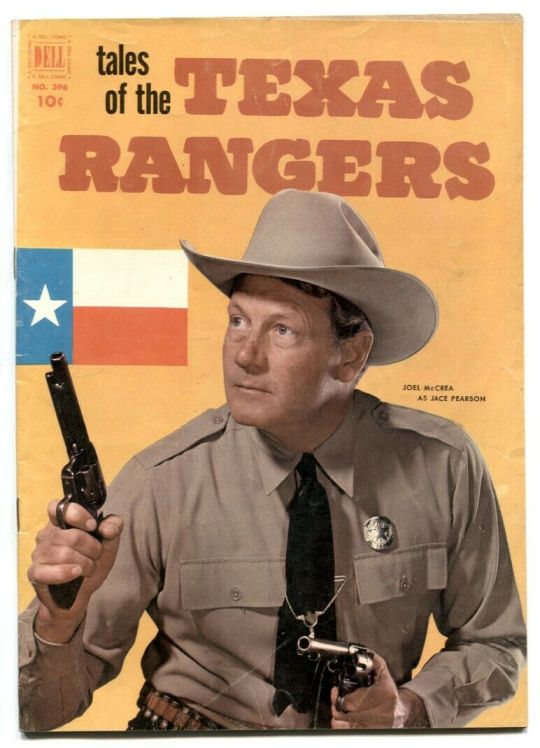
The Rangers had a long reputation as iconic lawmen of the west. The group was created when Stephen Austin recruited a small cadre of men to protect settlers in the territory following the Mexican war for independence from Spain in 1823. When Texas became a republic, the Rangers fought off Native Americans and took part in battles during the Mexican-American War. Following a brief suspension during the Civil War, the Rangers were reassembled in 1873 and their reputation (and legend) took shape in the hearts and minds of Texans. They fought Indians and chased outlaws. Among the notable criminals caught (and killed) by Rangers were bank robber Sam Bass and the legendary Bonnie and Clyde (as recently dramatized in the terrific Netflix movie The Highwaymen).
Producer/director Stacy Keach (father of Mike Hammer star Stacy Keach, Jr.) initially envisioned a feature film based on the exploits of the Texas Rangers but he shifted his focus to a radio series. At the time the series premiered, there were only 50 Rangers on duty, adding to the mystique of the frontier lawman. Keach explained the job of the Rangers was “to solve major crimes using known scientific devices, old-fashioned tracking techniques, and psychological analysis.“
Like Jack Webb and the Los Angeles Police Department in Dragnet, Keach had to obtain the cooperation of the Texas Rangers. Each script required official approval from the Rangers’ office. Fortunately, Keach and his writers found a patron and a muse in Captain M.T. "Lone Wolf” Gonzaullas, a 30 year veteran of the Rangers who claimed to have killed 31 men during his time on the force. Keach said twenty percent of the stories produced on Tales of the Texas Rangers came from Gonzaullas’ personal experiences. As Keach recalled later, “[Gonzaullas] never could remember our writers’ names, but he could recall names, dates, and places of every case he had ever worked on.” His cooperation allowed Keach and his team access to Ranger case files and interviews with the men behind the legends. Some case reports were brief, but colorful. Examples included “Shot all to pieces, but not serious,” and “Had a little shootin’ match. They lost.”
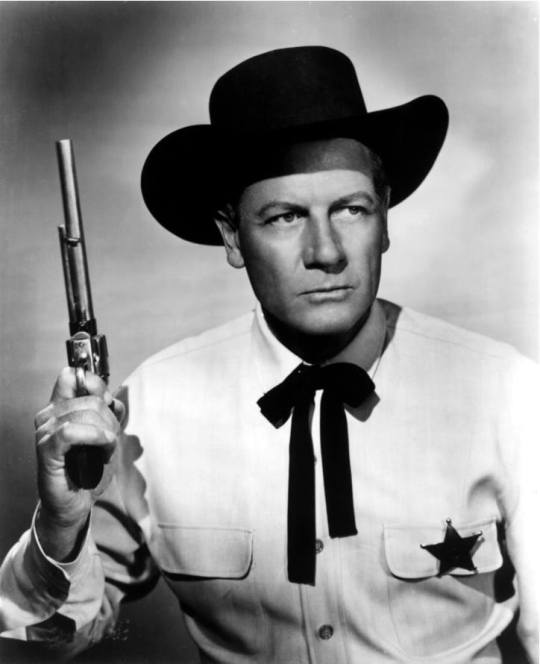
The series found its star in an actor who was entering his third decade in show business. Joel McCrea started in Hollywood in the late 1920s as a stand-in for some of the stars of the silent film era, including Rudolph Valentino. He got his first major movie role in 1934 and embarked on a career as a leading man. McCrea starred in films from Preston Sturges (Sullivan’s Travels) and Alfred Hitchcock (Foreign Correspondent), but admitted he felt most comfortable in the Stetson and spurs garb that Westerns offered.
“I liked doing comedies, but as I got older I was better suited to do Westerns. Because I think it becomes unattractive for an older fellow trying to look young, falling in love with attractive girls in those kinds of situations. Anyway, I always felt so much more comfortable in the Western. The minute I got a horse and a hat and a pair of boots on, I felt easier. I didn’t feel like I was an actor anymore. I felt like I was the guy out there doing it.”
McCrea lent a tough, no-nonsense air to the lead role of Ranger Jayce Pearson. He’s Joe Friday with a touch of Gary Cooper; Wyatt Earp with a radio and forensic knowledge.
The series premiered on NBC, the home of Dragnet, and featured many of the same supporting actors who popped up on that Jack Webb series, including Parley Baer, Stacy Harris, Tony Barrett, and Barney Phillips. Keach also employed some of the same sound effects crew from Dragnet. While the soundscapes for the two shows were very different, both benefited from a very real, authentic sound to the proceedings. Hoofbeats, footsteps on rocky terrain, lonesome train whistles, and the sounds of the prairie were commonplace and helped to ground the series as docudrama.
Though it had a relatively short run (another radio series that arrived on the wrong end of television’s debut), Tales of the Texas Rangers is a unique entry in the world of radio detectives. As a then-present day Western, it was a rarity in and of itself, but the combination of cowboy justice and methodical police work (backed up by taut scripts and production values) makes it worth a listen to audiences today.
1 note
·
View note
Text
sprouting from the root
Growing up with a negative self-image has led to the unimaginable. I hated what I saw in the mirror. I didn’t always feel this way. As a little girl, I was stress-free and didn’t feel the pressure of having to impress anyone. Society put the thought in my mind that to be normal you had to be a size 2, straight-A student, and most importantly White. Kind of impossible when you’re an overweight Mexican girl. From then on out my mental health continued to get worse. The only way to overcome this negativity was through motivation.
Although family can be a great motivator, it can also be an enormous stressor. There’s nothing I wouldn’t do in the world to give them a better life, considering what they have done for me. Growing up, both my parents came from low-income households with strong independent single mothers. Their fathers were not in the picture, but that never stopped them from doing what’s best for their kids. With the hope of giving us a better life, my father worked hard in school so that he could further his education and get a good job. He didn’t want us to ever worry about whether we had food on the table or a roof over our heads. Even though this motivates me to do better in school, it puts a lot of pressure on me. There is always a piece of me that feels like I am going to disappoint my father.
My brother and sister both have felt this same pressure on them. This has caused their mental health to suffer-especially my brothers. I tried explaining to my parents that they were too hard on us, but they didn’t understand. All my parents would say things like, “Why can’t you just be happy?” or “You don’t know what stress is.” The day my mom finally realized where we were coming from was when I told her that my brother had tried to kill himself. I remember that conversation like it was yesterday. “I don’t know why you and siblings complain about being stressed if you guys have a great life”. That was the day that I realized my mom wasn’t educated about mental health and the effects it has on people. “I know we have a great life; it isn’t even about that. You guys don’t know how much stress we have and how much pressure y’all put on us” “We don’t put pressure on you guys” “Really? Cause last time I checked, it isn’t normal for kids to feel the need to kill themselves”. Tears rolled down our cheeks as we sat in silence. It was uncomfortable but I knew that from now on things were going to be different.
When my mother was 7 months pregnant with me my father received news that his job was moving him to the United States. After being presented with the opportunity, my family hopped on a plane to head to Wilmington, North Carolina. My parents were excited to start their new lives in the “land of opportunities”. Living in Wilmington seemed like a dream with a safe neighborhood, great school district and amazing weather. It wasn’t until I started school that I realized everything was great, except for the people. Going to school was a living nightmare. The kids would look at me differently and judge me because of the color of my skin. I recall this one time a little boy told me I looked like a “Mexican jumping bean” and asked me if I “swam here”. I didn’t think anything of it because I didn't even know what that meant. I sat there confused as the kids laughed at the racist remark. Coming home I told my brother and sister about the incident that happened in class. They told to me that they were just being bullies and not let it get to me. Now that I think back to that moment it upsets me to think that kids that young could be so cruel.
Throughout the years I grew to ignore the things they said to me and accepted that I was never going to be “normal” to them. After all the hate I still found a way to make some friends and even met more Hispanic kids. Although things were getting better, I still felt that I needed to try a little harder than everyone else to fit in. As if it was my fault that kids didn’t like me. I didn’t feel happy, it wasn’t until the day I came home from school and my parents told us that my dad had been hired at a new job and that we would be moving to Sugarland, Texas.
It was exciting to know that I had another chance at making a good impression. I had no prior knowledge of Texas; all I knew was what Sandy Cheeks taught me off of SpongeBob. Because of this, I thought that it was going to be a hot desert and that I would wear cowgirl boots and shorts to school. I was completely wrong. We moved here during the summer, so it was hot, but it wasn't like a desert at all. Houston was big and bright (something I wasn’t used to since I grew up in a small town). Since I moved there in the summer, I didn’t really have much of a chance to make new friends, so I just had to wait it out until I went back to school. Going back to school was nerve-wracking because this would mean I'd have to make friends again and in the past being Mexican didn’t give me much of an advantage. Being Mexican in North Carolina meant being different, and not in a good way.
My first day at Dulles Middle School was nothing like I'd expected. The diversity in that school was ridiculous. Everywhere I looked I saw a different race. Mexicans, African Americans, Asians, Middle Eastern, it was like culture shock. The diversity I saw was overwhelming, and for the first time in my life, I felt as if I could fit in. It wouldn’t have been a proper first day if something embarrassing didn’t happen. Most of the middle schoolers were used to going off a 7-period schedule. I, on the other hand, was still so used to block classes. So, while everyone was in their 6th-period class I was in my 7th-period gym class. As soon as we figured out what class I was supposed to be in my gym teacher sent one of his students to show me where my class was at. Walking out of the gym the girl began to make small talk, “so are you new here?”, “Yeah, I just moved here” I replied. We had an awkward pause. “Well if you want, we can be friends”. Soon enough we were inseparable.
Before school started my mother had to fill out some papers and on one of the papers it asked what my first language is. My mom obviously put Spanish since that is the language I spoke at home. Assuming I only spoke Spanish, the school put me into an ESL class which is a class for students that just started learning English. At first, I didn’t think anything of it; I just assumed I was put in the class because I just moved to Texas. As the class progressed, I began to feel like the class was too easy, so I spoke with the teacher and requested a schedule change. The teacher began to rant to the class about me wanting a schedule change. “If you think that you are SOOO smart then how about you answer these questions”? She proceeded to ask me questions in front of the class and I got every single one right. That same afternoon I was pulled in the counselor’s office to switch me out.
Once they switched me into a regular class, everything fell into place. The girl I had met earlier was in the English class they switched me into, so I began to feel more comfortable. “Hey! Come sit next to me.” I sat quickly before the bell rang. “My name’s Kaylee, by the way.” “I’m Jonelle.” Soon enough we were inseparable. By the end of the year, I began to feel welcomed in a way I never felt back home. As time went by, I made new friends, friends of different races and cultures. The next year I even worked up the courage to try out for the cheer team and as a result, I wound up with more friends than I could even imagine. Life was going great; I was happier than as I’d ever been. As 8th grade came to an end, my family bought a house a little further down in the neighboring town of Missouri City. Sadly, this would mean I'd have to move to a different high school and leave all my new friends behind. I was scared that all the friends I had made in the past two years were just going to forget about me.
To help me transition into high school, my mom thought that it would be a good idea for me to try out for the cheer team. Sadly, I missed tryouts, so she told me that the high school I was going to attend had a dance team and asked me if I wanted to give it a shot. I always had a love for dancing but never actually took classes, so I decided to audition. Most of the girls that were trying out already knew each other from middle school so I stayed to myself throughout the whole process. At the end of the day, they posted the numbers of the girls who had made the team and I was one of them. I was so happy that I was going to start this new chapter in my life and get to know more people.
Once school rolled around, I started feeling that same sense of being left out. Going from an extremely diverse school to a predominantly black school was difficult to adjust to. I always felt like I was too Mexican for the white kids, too white for the black kids and too Americanized for the Mexican kids. It was a vicious loop. As the year went by, I struggled to fit in anywhere but dance. Dance was my way of expressing how I felt. I had just left a school where I had many friends. After moving to my new school, I barely spoke to any of my friends. This had a huge effect on my mental health which caused me to start slacking in my schoolwork. At this point, I didn’t feel happy anywhere, not even in my own home. Come sophomore year I was depressed, and not even dance could help me. I’d come home crying and begging my mom to transfer me back to Dulles but there wasn’t anything she could do. She would tell me to make the most out of it and just focus on my grades and dance.
I was in a dark place, I felt abandoned, not even my best friend was there for me. She would rather hang out with her boyfriend than me. The worst part was that he didn’t want her to hang out with me because he told her I was a “whore”. When she told me what he said I was devastated, I couldn’t believe some guy was calling me such horrific names without even knowing me. His racism was what kept me and Kaylee apart, he didn’t like the fact that I liked black boys or that I went to a predominantly black school. I truly had no one to talk to, not even my family.
Knowing how my parents were, I was too scared to tell them how I felt in fear of them telling me I’m overreacting and that I have no reason to be depressed because I have food on my plate and a roof above my head. Instead of asking for help I bottled up my emotions and kept it to myself. I spent my days locked up in my room and refused to eat. At this point, I had lost 20 pounds in one month. To people I looked perfectly fine and happy but, on the inside, I was just rotting away. I hated the way I looked, the way I acted, I hated myself.
As junior year was approaching my grades went from C’s to A’s. The motivation I once had was starting to come back but even stronger than before. I reconnected with my friends Allie and Skyler and I began to make more friends because of them. Dance also helped me find my crowd. It wasn’t just a distraction at this point, dancing was fun and because of that, my team became like another family. The most influential person I met on the team was Ashlyn Sydney Gipson. She reminded me of the importance of self-worth and taught me to never let anybody walk over me. A sisterhood bond formed over the love of dance.
Although my social life was getting better, I still felt kind of lost. Mixed emotions filled my head daily. Was I happy? Was I sad? At that point, I had no clue. My initial thought was that my hormones were out of whack, so I just ignored it and went on about my year. The sound of the bell on the last day of school was like angels singing. That bell meant that as of that moment we were seniors and that summer was going to be the best one yet. I was finally happy and had lots of plans with my friends.
Throughout the summer I spent almost every day at the pool, I mean I was a lifeguard but even when I was off of work. If I wasn’t at the pool, then I was at Allie and Skyler’s house working on a tan or going on late night adventures. Even towards the end of the summer I still felt excited because that meant that this was going to be my last year of high school. The excitement of college was the only thing on my mind. My first week of senior year was a blast.
Towards the end of November, things started to feel rushed. I was so caught up on having fun that I forget that I had to take my SAT. Not only was I behind academically but I started to realize that I didn’t know what I was going to do in life. Somehow, I thought that the second I graduated I was going to be handed a slip telling me what I was supposed to become. I got accepted into Texas State and already had a roommate, but it still didn’t feel right. Was my happiness temporary? Why did I feel like a baby bird being pushed out of its nest with no clue that I had to fly? This wasn’t how I wanted things to go. I was supposed to graduate high school and have my career planned out so that I could make my father proud.
My whole life I was told that happiness was shown with a smile. What if underneath that smile was an unhappy person? No one told me that for one to truly be happy they had to be happy with themselves. This whole time I was letting what people said or thought about me affect my mental health. The key to my happiness.
[ A lot of things went through my mind while writing this memoir. When I first started the outline I wasn't being completely honest with myself. After doing some research I knew that for it to be a real memoir I had to be truthful. The outcome wasn't exactly what I expected but I think it came out alright. In the future, I could possibly see myself furthering this memoir, maybe even post more of my writing. ]
1 note
·
View note
Text
THE KILLER SHREWS on the Schlocky Horror Picture Show
August 03, 2008
OPENING: Hello, good evening, and welcome to the Schlocky Horror Picture Show. I'm your host, Nigel Honeybone. As the 1950's grew to a close so did the era of the giant radioactive beast. Spawned from the nuclear fears stemming from World War II, the movies saw dozens of animals super-sized due to one of the popular catch words of the time: Radiation!
By decades end, just about every manner of giant beastie had been seen. Lizards, spiders, ants, grasshoppers, the list goes on. The major studios had lost the inclination to finance such projects, and gradually re-focused their attention on new trends like nudies, bikies and gothic horror. That is not to say that movies with ginogorous critters didn't exist. It's just that, more often than not, it was left to the little guy, the independent producer or filmmaking rookie to unleash such monsters. Witness tonight, if you dare, as a group of people trapped on an island during a storm must contend with a bunch of whippets in wigs, in the 1959 anti-classic, Attack Of The Killer Shrews!
BREAK: Don't go away, we'll be right back with more dogs In drag, and then after the ads we'll get back to the movie.
MIDDLE: Welcome back to the Schlocky Horror Picture Show. Attack Of The Killer Shrews, also known as just Killer Shrews, was the brainchild of Texas millionaire Gordon McLendon. Born in Paris, Texas in 1921 he would go on to win a nationwide political-essay contest, attend Yale University where he studied Far Eastern languages, work for the campus radio station, and served as business manager for the Yale Literary Magazine, all before the U.S. got involved in World War Two. After the war he bought an interest in a radio station and built up a following for his live baseball game broadcasts. Having built up quite a name for himself as a pioneer in the radio field, McLendon now turned his attention to film...a regrettable decision for producer and audience alike.
He and his family owned several drive-ins and theatres. Like many drive-in owners discovered, their outlets for screening films were considered the bottom of the barrel by the pretentious lot in Hollywood and many in tinseltown tried their darndest to keep their films out of the drive-in chains. This only led to the drive-in owners taking the next logical step, they financed their own films. In 1959 McLendon financed three films: The Killer Shrews, The Giant Gila Monster, and My Dog Buddy, none of which are remembered as sterling examples of cinematic skill, if they're remembered at all.
James Best, known far and wide as Sheriff Roscoe P. Coltrane on television's original Dukes of Hazzard, plays Thorne Sherman and captains his own ship. Sounds cool, but sadly it isn't any bigger than the SS Minnow, and the only person he has to boss around is Rook. He's a glorified gopher, delivering supplies out to Doctor Craigis on his island. Sherman is a man's man, which by 1950s terms means he drinks like a fish, smokes like a chimney, has an appreciative eye for the ladies and is ready for a fistfight on a moment's notice, the kind of simplistic brute we are gradually evolving away from, a little too slowly if you ask me.
His Honour Judge Henry Dupree plays Rook Griswold and looks like he could have played the title role in that live action Fat Albert movie: Hey, hey, hey! He's Sherman's sole crewman, although the two seem to share a real friendship rather than just bossy Captain/abused crew dynamic. Poor Rook is the first person to bite it in The Killer Shrews, or more accurately, the first to get bitten. Repeatedly, as a matter of fact. In this way this film helped start the stereotype of the token black character becoming the first victim in horror films. You may think films like Night Of The Living Dead and Alien were breakthroughs for the token black character in American horror, but a pessimist might say they simply get more screen-time before being killed-off.
Baruch Lumet plays Doctor Marlowe Craigis. He may not seem like much, but he fathered one of Hollywoods greatest producer/directors, Sidney Lumet, famous for
Twelve Angry Men, Failsafe, The Pawnbroker and Dog Day Afternoon. Speaking of dogs, he also directed the all-black musical The Wiz starring Diana Ross and Michael Jackson. Nobody's perfect. Anyway, Craigis says he hails from Sweden, and has come to the island of The Killer Shrews to further his scientific work, but you and I both know it was to keep his sexy daughter out of the Swedish porn industry. Craigis wants to shrink people, or at least slow down our metabolisms so the Earth's resources will last longer when overpopulation becomes a big problem. I think a bigger problem might be smarmy foreign scientists who screw around with Mother Nature...
Swedish-born Ingrid Goude, a former Miss Universe, plays Ann Craigis, Doctor Craigis sexy daughter. She claims to be a zoologist, which is about as convincing as Nicole Kidman playing a brain surgeon. Though to be honest, I wouldn't mind checking-out her knowledge of biology, if you know what I mean, and I think you do. Ann serves no purpose here other than to scream on occasion, and to provide Captain Sherman with a new First Mate, if you know what I mean, and I think you do.
Ken Curtis, another famous redneck, plays Jerry Farrell, part of Doctor Craigis research team. Curtis was inducted into the Hall Of Great Western Performers in 1981 for his performance as Festus in almost 300 episodes of Gunsmoke. Jerry's vital role in the mission is whining, cowering, boozing it up and generally being a waste of skin. He despises Sherman from the start, probably because he recognises that Sherman is much more of a man than he ever will be. I wouldn't get attached to Jerry if I were you.
Played by Gordon McLendon, the Texas millionaire responsible for this mess Doctor Radford Baines is another one of the scientists helping Doctor Craigis with his work. This guy is really devoted to his work. In fact, he can hardly think of anything else and walks around muttering things like "Hematoxic Syndrome." His last moments on Earth are spent in devotion to science and furthering the understanding of mankind, instead of doing something really important like trying to get laid or run away.
Unknown Alfredo DeSoto plays Mario. Despite the Italian name, Mario is apparently Mexican. He's most likely a servant of some kind, though his main duty seems to be as a device to advance the plot. Whatever he does, it doesn't involve too much physical labor, as Mario's mid section is expanding faster than a balloon. He isn't around much. Just long enough to say things like "Si, senor," "No, senor" and "Aaaahhhh!". It also explains why the shrews ran out of food. Mario doesn't look like he was missing any meals...
Attack Of The Killer Shrews gives real meaning to the phrase Low Budget. Filmed on a mere handful of sets and featuring scene after scene of people talking, often with their back to the camera, with little in the way of action, and one could easily dismiss this as pure manure. The fact that the giant shrews are played by dogs in drag when they're not being represented by clumsy puppets, and one could not be blamed for turning up their nose at this movie. If there is a saving grace, it's the short running time. So yes, there's lots of boring talk, but there is also enough monster action to satisfy fans of such schlocky goodness.
Besides, I shouldn't have to explain how funny it is to watch somebody scream in terror at a Collie wearing carpet remnants, when the dog is rolling over on his back obviously expecting a belly rub! And it's with that thought in mind we now return you to the carnivorous canine creepiness that is Attack Of The Killer Shrews!
CLOSING: It's alright, you can open your eyes now. How exactly do Killer Shrews assimilate poison into their systems, anyway? For instance, I love to drink Absinthe, and I do mean Absinthe, not that over-the-counter swill. I've consumed hundreds if not thousands of litres of it over the years, over three thousand litres just in the last fifteen years, but I still haven't started frothing with green poison yet. If I can't assimilate my own favourite
beverage after drinking thousands of bottles, how can the shrews do so with poison after just one sampling of it?
Anyway, please join me next week so I can poke you in the eye with another frightful excursion to the backside of the Public Domain, filmed in glorious 2-D black & white Regularscope on...The Schlocky Horror Picture Show. Toodles!
by Lushscreamqueen
1 note
·
View note
Text
Tequiza Sunset: A History of Anheuser-Buschs Agave-Infused Corona Killer That Wasnt
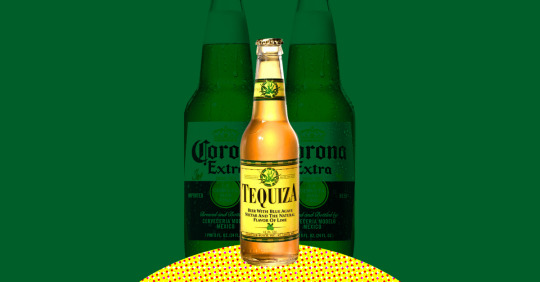
It’s the turn of the century, and you’re at SeaWorld San Diego, a sprawling complex of saltwater semi-captivity that Anheuser-Busch, the country’s largest beer company, has owned for the past decade. But you don’t care about who owns the place. You’re just there because some guy who works for a beer brand you’ve barely heard of invited you and 300 other 21- to 25-year-olds to the compound to see some dolphins and drink some free suds. Is it weird that he hired a limo to drive you and a bunch of strangers to SeaWorld? Kind of, but hey — it’s Y2K, baby! Anything goes!
“At the time, there’s no such thing as Uber, so from a liability standpoint, we had to pick them up and drop them off. … We got like every taxi in town — buses, limos, whatever was available — to take these people back and forth,” says Edmundo Macias, Tequiza’s former brand manager. “We said let’s throw a big party, and there’s gonna be free Tequiza.”
Introduced in 1997 to ride the first wave of American tequila curiosity and protect St. Louis’s flank from growing threats from imports and spirits, Tequiza was A-B’s hottest new product launch of the ‘90s, rolling out con gusto across the American South and West to solid early sales. A Brandweek article from February 2000 that Macias shared with VinePair proclaimed that “Tequiza was launched cheap by A-B standards and already has eclipsed No.1 craft beer brand Sam Adams in volume, putting it well on the way to 1 million barrels.”
But that was then. The brand never hit a million barrels, and never gained any sustained traction with American drinkers. Tequiza limped along for another decade or so until A-B — which by then had been reconstituted as Anheuser-Busch InBev — retired the beer from its rotation for good. What happened to Tequiza? It’s a classic tale of cross-segment ambition, dubious distributors, and flagship fealty. But even though the beer itself has long since hit the trail, Tequiza’s liquid legacy helped spawn the flavored malt beverage boom currently remaking the American drinking landscape.
“It was ahead of its time,” says Gerry Khermousch, the former Brandweek editor, who has covered the beer and non-alcoholic beverage industries for decades. But what a time it was. Here’s how it all went down.
Blending trends: tequila & cerveza
Some beers are borne of centuries of tradition, of closely held recipes, of many generations of brewers learning from those who came before. Tequiza’s origin story, on the other hand, is entirely contained in its awkwardly bilingual portmanteau of a name. The beer was a drinkable embodiment of a couple contemporary trends A-B hoped to tap into:
The premiumization of full-proof tequila amidst full-proof spirits’ growing popularity with American drinkers
The remarkable deluge of imported Mexican lagers, led by what was in hindsight one of beers’ first lifestyle brands — Corona
Both strategies represented A-B playing defense — or more charitably, insurance — with its market might. Categories in the late ‘90s were much more segregated than they are today, and losing a lifelong beer drinker to full-proof spirits was anathema to a company like A-B. But peeling them away from booze was tougher, too, recalls Tim Schoen, a three-decade Anheuser-Busch marketing veteran who worked on Tequiza, among other brands. “Back then the specific target was spirits drinkers. The spirits category was encroaching on the beer category and so [Tequiza] was certainly trying to attract some of those potential lost [beer] customers, the ones that [were] looking elsewhere.”
“Interest in hard liquor was starting to be resurgent,” echoes Colleen Beckemeyer. As A-B’s director of new products through the ‘90s, she oversaw the launch of Tequiza. “Maybe tequila wasn’t the most upscale option for the hardcore liquor drinkers, but it did have its footprint in the Southwest. For that reason, I think it was kind of interesting to us,” she says.
To American drinkers, tequila was also interesting, period. The spirit was strong, far-flung yet available, and retained remarkable pop-cultural prominence before, during, and after Tequiza’s release. Consider:
1972: The Rolling Stones embarked on what Keith Richards would later recall in his memoir as “the cocaine and tequila sunrise” tour
1983: Shelly West’s “Jose Cuervo” topped country charts
The 1990s: Van Halen’s “Cabo Wabo” (released 1988) begot Sammy Hagar’s eponymous cantina concept (1990) and tequila (1996)
2002: “Jose Cuervo” was atop Billboard’s country charts again, courtesy of Tracy Byrd’s “Ten Rounds with Jose Cuervo.”
But while the agave distillate was some cause for concern, Tequiza’s bigger bogey was Mexican beer, and one brand in particular. “This was developed to try to compete with Corona,” says Macias, who worked for Beckemeyer on Tequiza’s rollout. “That was the genesis of the brand.”
Chasing Corona
The competition would be fierce. In 1998, Corona overtook Heineken as the U.S.’s best-selling import beer. “In less than a decade, Corona’s manufacturer, Grupo Modelo S.A. de C.V., has transformed a once-obscure Mexican beer into a global brand whose name recognition — if not its sales — approaches that of Coca-Cola and Marlboro cigarettes,” The New York Times noted the following year. Corona, with its endless-summer attitude, primo painted label, and iconic clear glass bottle, was a big deal in the U.S. beer business, and marked a tectonic shift in drinkers’ attention toward the southern border.
“Corona was a sensation, there’s no question about it,” says Benj Steinman, publisher of the long-running trade publication Beer Marketer’s Insights (BMI), “and it was strongest in the biggest market, California. A-B in the ‘90s was 50 share of the [beer] market in California. … They saw it as a problem.” William Knoedelseder, in his best-seller about the Busch family, “Bitter Brew,” reported that by 1991, A-B’s own internal research showed that Budweiser was slipping among “contemporary adult drinkers … who were turning to upstart American microbrew brands such as Samuel Adams and imports like Corona Extra.” Despite the runaway success of Bud Light — which had been introduced in 1982 and was, by the mid-90s, neck-and-neck with nemesis Miller Lite for America’s overall best-selling beer — drinkers’ excitement for the Mexican “vacation in a bottle” was enough to spur a response from A-B.
The response was Tequiza. By the time Macias moved from A-B’s Hispanic marketing team to new products in 1998, the Tequiza experiment was already rolling. Both he and Beckemeyer say the liquid itself was developed by A-B brewer Jill Vaughn, who incorporated agave nectar and actual tequila into the brew at A-B’s St. Louis pilot brewery. “She really was able to help bridge the brewing and the marketing” considerations for Tequiza, says Beckemeyer. (Vaughn no longer works for the company and did not respond to messages sent via social media.)
Maybe even more calculated than the liquid itself was the vessel that it would be sold in: 12-ounce clear-glass longnecks, Corona-style. “Corona owned clear glass, and they still do, to a certain extent,” says Schoen. Selling Tequiza in similar packaging, with a similar, bold yellow color scheme, was a way to get customers keen on A-B’s would-be Corona counterpoint. “The clear bottle was really the standard, and we didn’t necessarily want to deviate from that,” says Beckemeyer of the decision.
Selling sweetness
But was it ever any good? Opinions differ on this front. “The product was great,” says Schoen. Macias remembers early iterations being too sweet, something he believes hamstrung the offering among male consumers, and the brew was reformulated at least once after complaints of sweetness from rank-and-file drinkers.
“I remember the first test market was someplace in Texas,” said Beckemeyer. “I was out and we were having a first batch, and it was terrible. It was so sweet. So we went back to the drawing board and made it less sweet.”
A canvass of review forums suggests Tequiza was, at best, a polarizing option among American drinkers. The beer boasts an impressive all-time rating of 0 on RateBeer.com, and a score of 50 (“Awful”) on BeerAdvocate. It’s hard to say how many of those reviews came from people who’d actually tasted the beer, though, and the brand clearly had some fans. When news of its discontinuation hit the internet, real Tequiza heads made their distress known. “The only beer my dad has ever liked was Tequiza, which is now out of business. Any recommendations of something similar?” queried one redditor in 2012.
Regardless, Tequiza’s national debut in 1999 predated the heyday of user-generated review forums like RateBeer and BeerAdvocate. Traditional advertising, marketing, and distribution still held serious sway over the average supermarket shopper looking for a 6-pack. “We had initial success right out the gate, and what we kept hearing was, ‘I don’t normally drink beer but I would drink this,’” says Macias, adding that that feedback mostly came from women. The team rolled the beer out with the print and billboard ads with the slogan “Give it a shot” to suggest full-proof braggadocio, plus a radio spot featuring a riff on The Champs’ horn-heavy 1958 classic, “Tequila.”
The ads may have helped, though Macias believes that A-B never gave Tequiza enough money to really give the brand a fighting chance with more sustained marketing or a costly TV commercial. Marketing for A-B’s new products all came from a shared budget, so “if you’re spending that money on Tequiza, that means you’re not going to [be able to] spend money on other innovations,” he says. And with no obvious ties to the firm’s flagships, A-B had no obligation to throw money at Tequiza’s post-launch performance. If it did well on a shoestring, great. If not, the company could cut bait without damaging the aura of its portfolio champions. “If it was part of the Bud Light family, or Budweiser, or even Michelob at that point, it would have had a separate, sizable budget,” speculates Macias.
(A spokesperson for Anheuser-Busch InBev, Lacey Clifford, says the company today doesn’t employ any “relevant spokespeople who could discuss [Tequiza] in any kind of detail.”)
But more than anything, Tequiza — or any beer in any macrobrewers’ U.S. portfolio, really — needed buy-in from drinkers to succeed. And to get in front of drinkers at retail, it needed support from distributors. A-B’s much-ballyhooed, nominally independent wholesaler network was the envy of the industry in 1999, and it went to work in service of St. Louis’s latest creation.
“They blasted [Tequiza] out, like they often are able to do with that distribution system,” says Steinman. “That just really [got] the product out immediately and everywhere.” Wholesalers aligned with A-B were thirsty for a beer to offer retailers fielding increased demand for Corona. They didn’t have rights to distribute actual Corona in the U.S. at the time (particularly vexing given that A-B then owned 50 percent of the brand’s parent company, Grupo Modelo) but how about this product that looks like it, and has real imported agave and tequila in it to boot?
According to BMI’s internal figures, Tequiza sold 570,000 barrels in 1999 — a respectable national debut. “That’s pretty good,” allows Steinman. But Macias knew it wasn’t enough to secure Tequiza a permanent spot in A-B’s portfolio. “A lot of smaller companies would love to have 600,000 barrels … but we [Anheuser-Busch] spill more than that,” he says. Tequiza’s agave-based sweetness was holding it back from popularity with male drinkers, a vital cohort. “As I’d sit in these focus groups, especially with males, they would say, ‘It’s too sweet, not enough tequila taste, and we [want] something with higher alcohol.’” (Hence the SeaWorld San Diego mission: a mass taste-test to gauge the popularity of three different Tequiza formulas, each with a varying amount of agave sweetener.)
In a bid to convince hard-drinking American dudes to, as the slogan said, “give it a shot,” Macias pitched the idea for Tequiza Extra — higher alcohol, less sweetness, and a black label that didn’t even mention agave. “It looked almost like a Cuervo bottle, the fonts were similar,” says the one-time brand manager, who these days works for a San Antonio spice company, Twang, that back in the day had provided flavored salt packets for Tequiza’s launch. “I thought it had all the potential in the world, but when we introduced it at one of the big distributor conventions, we kept hearing the distributors [say] ‘that’s not something I would drink.’”
“That basically killed the brand,” he concludes.
But Steinman is skeptical. “If the distributors weren’t signing up for repeats, that’s because the consumer wasn’t really signing up for repeats,” he says, adding that the fact that A-B never sprung for Tequiza TV ads was “not dispositive” of its eventual failure, either. In other words: If people wanted to drink Tequiza, wholesalers would have kept ordering more, regardless of whether it was on TV or what they personally thought of it.
Schoen offers another important bit of context. “There was one reason [Tequiza] didn’t work at the time, and that reason is very simple: Bud Light growth,” he says. Between 1990 and 2000, A-B went from producing over 11 million barrels of its flagship light adjunct lager to over 31 million barrels, per “Brewing Industry” by Victor J. and Carol Horton Tremblay. (The economic reference text opted not to even bother with Tequiza’s category, known then as “phantom specialty,” because it was too small to merit mention, and “malt-alternatives are not close substitutes for beer.”) “It was on just an incredible run, so [Tequiza] got what we’ll call ‘mixed’ distributor support and execution. There were so many other things [wholesalers] were doing” at that time that Tequiza simply wasn’t as much of a priority, remembers Schoen.
“I don’t know if wholesalers lost interest or consumers lost interest, but for whatever reason, there just wasn’t as much interest,” says Beckemeyer. Why dwell on Tequiza? A-B had the Bud Light juggernaut; the first craft beer boom was busting; and products like “Doc” Otis’ Hard Lemon malt beverage were testing well with consumers. “We [weren’t] going to fight a tidal wave,” she explains. And so Tequiza was swept away. The brand was still available in select markets until 2009, but it was effectively “gone by 2005,” says Steinman.
The Tequiza legacy
Tequiza’s short life wasn’t particularly glamorous — unless you count radio ads and SeaWorld glamorous — but it wasn’t totally pointless, either. Tequiza’s legacy, to the extent that it left one, can be traced in the products A-B and ABI pursued once it was gone. After unceremoniously laying the brand to rest, A-B leaned more heavily into flavored beers. In 2006, A-B released Shock Top, brewed with orange and lemon peel; in 2009, Bud Light Lime (a “significant new entry” for its time, says Steinman); and in 2012, Bud Light Lime-A-Ritas, full-blown fruited FMBs. Vaughn herself was involved in the development of nearly all of them. Tequiza made A-B “more comfortable with the [idea of] introducing flavors to a beer,” says Beckemeyer. “That was a foreign idea at the time.”
With the benefit of hindsight, Tequiza, like Coors’ Zima, another contemporary FMB punchline/product, could be seen as a premonition of American drinkers’ recent thirst for FMBs, canned cocktails, and perceived “better for you” ingredients. Schoen (whose current firm, BrewHub, works with several clients that use agave in their products, with more on the way) points to the red-hot popularity of the loosely defined Ranch Water category as an indication that A-B’s agave-infused failure was the right idea at the wrong time. In its day, Tequiza “just wasn’t big enough to make it sustainable,” he says. “But I would argue that if someone had it out there today, it would have been a hell of an entry.”
The article Tequiza Sunset: A History of Anheuser-Busch’s Agave-Infused Corona Killer That Wasn’t appeared first on VinePair.
Via https://vinepair.com/articles/tequiza-agave-infused-ber/
source https://vinology1.weebly.com/blog/tequiza-sunset-a-history-of-anheuser-buschs-agave-infused-corona-killer-that-wasnt
0 notes
Link
5 years of hate
1 hr ago
At the first presidential debate of the 2020 election, President Donald Trump shocked many viewers when he was given an opportunity to condemn white supremacists but declined. The president then told the Proud Boys, an alt-right hate organization, to “stand back” and “stand by.”
While Trump’s refusal to condemn white supremacists was the talk of the debate, his decision to skirt the subject is precisely in line with how he’s historically addressed violence on the part of hate groups and his supporters: He emboldens it.
As far back as 2015, Trump has been connected to documented acts of violence, with perpetrators claiming that he was even their inspiration. In fact, almost five dozen people, according to reports from the Guardian and ABC News, have enacted violence in Trump’s name.
In 2016, a white man told officers, “Donald Trump will fix them” while being arrested for threatening his Black neighbors with a knife. That same year, a Florida man threatened to burn down a house next to his because a Muslim family purchased it, citing Trump’s Muslim ban made it a reason for “concern.” Then there are the more widely known examples, like Cesar Sayoc, who mailed 16 inoperative pipe bombs to Democratic leaders and referred to Trump as a “surrogate father,” and the mass shooting in El Paso, Texas, in 2019 that left 23 dead, where the shooter’s manifesto parroted Trump’s rhetoric about immigrants.
In some cases, Trump initially denounces the violence, but he often walks back such statements, returning to a message of hate and harm. Recently, he defended a teenage supporter who gunned down three people at a Black Lives Matter protest. And on Thursday, he refused to condemn the domestic terrorists who allegedly planned to violently kidnap Michigan Gov. Gretchen Whitmer. Instead, he criticized Whitmer and fished for compliments.
Trump has continually failed to recognize what’s at the core of this violence: hate that’s been nurtured under a tense national climate that he has helped cultivate.
Trump’s campaign rallies have always been incubation grounds for violence, the sites where Trump spewed hate speech that encouraged physical harm against dissenters. And as president, he has used his platform to encourage violence against American citizens, whether via the police and national guard or militia groups. Just this year alone, Trump infamously made it clear that protesters — those out demonstrating against police brutality and systemic racism — should be met with force.
As much as the president and his supporters have to paint the picture that the cities and suburbs will burn in violence under a Joe Biden presidency, Trump is the one who has repeatedly proven that he has no interest in promoting peace.
Here is a timeline of Trump’s hateful rhetoric since 2015 and some of the moments when his supporters took heed.
2015: Trump officially announces his campaign for president and immediately employs rhetoric that suggests violence is the answer to opposition
Trump officially announced his candidacy for president of the United States in June 2015 and wasted little time inciting fear and hate in his first speech. That year, critics argued that his language led to attacks on innocent bystanders, and in some cases, acts of violence were directly connected to Trump’s words.
June 16, 2015: When Trump announced his bid for president at Trump Tower in New York City, he made disparaging comments about Mexicans, comments that have been said to incite violence and hate toward immigrants for years to come:
“When Mexico sends its people, they’re not sending their best. They’re not sending you. They’re not sending you. They’re sending people that have lots of problems, and they’re bringing those problems with us. They’re bringing drugs. They’re bringing crime. They’re rapists. And some, I assume, are good people.”
Even though his statement was almost entirely false, in the months following, Trump would defend the criminal threat of immigrants. “What can be simpler or more accurately stated? The Mexican Government is forcing their most unwanted people into the United States. They are, in many cases, criminals, drug dealers, rapists, etc.,” he said on July 6, 2015.
August 11, 2015: Trump indirectly took aim at Black Lives Matter protesters, calling Sen. Bernie Sanders “weak” after Sanders allowed protesters to seize the microphone at a campaign rally. “I thought that was disgusting. That showed such weakness — the way he was taken away by two young women. … They just took the whole place over.”
Trump added, “That will never happen with me. I don’t know if I’ll do the fighting myself or if other people will. But that was a disgrace. … I felt badly for him, but it showed that he’s weak.”
August 19, 2015: Two Boston brothers invoked Trump when they were arrested for urinating on a homeless man and beating him with a metal pipe. While in custody, one of the brothers told the police, “Trump was right. All of these illegals need to be deported.” The 58-year-old Mexican man they assaulted was a permanent resident.
In response to the news that the Boston assault was inspired by his rhetoric, Trump did not denounce the violence, instead calling his supporters “passionate.” “I think that would be a shame. I will say, the people that are following me are very passionate. They love this country. They want this country to be great again. But they are very passionate. I will say that,” he told reporters the next day.
On August 21, 2015, Trump backtracked a bit, taking a both-sides approach. “Boston incident is terrible. We need energy and passion, but we must treat each other with respect. I would never condone violence,” he tweeted.
October 23, 2015: After repeatedly being interrupted by protesters at a campaign rally in Miami, Trump warned he’ll “be a little more violent” next time when addressing protesters. “See the first group, I was nice. ‘Oh, take your time.’ The second group, I was pretty nice. The third group, I’ll be a little more violent. And the fourth group, I’ll say get the hell out of here!” he said. On video, the pro-immigration protesters could be seen being forcibly dragged out of the campaign event.
November 21, 2015: At a rally in Birmingham, Alabama, Trump demanded the removal of Black activist Mercutio Southall Jr. after he yelled, “Black lives matter!” Onstage, Trump exclaimed, “Get him the hell out of here! Get him out of here! Throw him out!” In a video captured by CNN, Southall fell to the ground as Trump made his statements and white men appeared to kick and punch him.
As security guards removed Southall from the rally, the crowd chanted, “All lives matter,” according to the Washington Post. Trump told Fox News the next day, “Maybe he should have been roughed up, because it was absolutely disgusting what he was doing. I have a lot of fans, and they were not happy about it. And this was a very obnoxious guy who was a troublemaker who was looking to make trouble.”
December 2015: The Trump campaign devised a strategy to address protesters who demonstrated at rallies. Instead of harming the protester, the campaign suggested they chant, “Trump! Trump! Trump!” until a security guard removes the protester. The campaign began playing an announcement of the plan at rallies in mid-December, which started with the line, “If a protester starts demonstrating in the area around you, please do not touch or harm the protester. This is a peaceful rally.” According to the Washington Post, attendees laughed when the announcement was played at a rally.
2016: At campaign rallies, Trump models the violence that he encourages by making a spectacle out of ejecting protesters
At his large campaign rallies, Trump became notorious for yelling “Get ’em out!” at protesters who demonstrated, whether they stood there silently, held up a sign, or chanted. Though Trump often alleged that the protesters were violent, reporters found no evidence to suggest that protesters ever attacked Trump supporters inside any rally.
In 2016, Trump sharpened his rhetoric against Muslims, suggesting that the country must scrutinize mosques and newly arrived Muslim migrants. The year 2016 also gave rise to the chant that advocated for violence against then-Democratic presidential frontrunner Hillary Clinton: “Lock her up!”
January 8, 2016: Rose Hamid, a 56-year-old Muslim woman wearing a hijab, was escorted out of a Trump rally after standing up in silent protest over Trump’s speech in which he said Syrian refugees fleeing war were affiliated with ISIS. Hamid attended the rally to show Trump supporters what Muslims are like (Trump had already called for a “total and complete shutdown of Muslims entering the United States” in December 2015), and told CNN’s Don Lemon that the people sitting around her were “very nice” and “sharing their popcorn.”
But once the crowd “got this hateful crowd mentality,” as she was being escorted out, “it was a vivid example of what happens when you start using this hateful rhetoric and how it can incite a crowd where moments ago were very kind to me.” Hamid said one man yelled to her, “Get out! Do you have a bomb? Do you have a bomb?”
January 23, 2016: At a campaign rally in Iowa, Trump, in describing the loyalty of his supporters, notoriously said, “I could stand in the middle of 5th Avenue and shoot somebody and I wouldn’t lose voters.”
Video player from: YouTube (Privacy Policy, Terms)
February 1, 2016: At a campaign rally in Cedar Rapids, Iowa, Trump told the crowd that his security team informed him that there may be somebody throwing tomatoes. “If you see somebody getting ready to throw a tomato, knock the crap out of them, would you? Seriously. Just knock the hell out of them. I promise you, I will pay for the legal fees. I promise. There won’t be so much of them because the courts agree with us,” he said.
Video player from: YouTube (Privacy Policy, Terms)
February 23, 2016: At a campaign rally in Las Vegas, Trump said of a protester, “I’d like to punch him in the face.” As security guards escorted the protester out of the rally, Trump mocked him, saying, “He’s smiling. Having a good time.” He then reminisced about being able to get away with violence: “There’s a guy, totally disruptive, throwing punches. We’re not allowed to punch back anymore. I love the old days. You know what they used to do to guys like that when they were in a place like this? They’d be carried out on a stretcher, folks.” Trump also called the protester “nasty as hell.” CNN reported that the man did not appear to fight with the security guards taking him outside.
Video player from: YouTube (Privacy Policy, Terms)
At the same rally, Trump would double down on his support for waterboarding, a banned interrogation method. “They said to me, ‘What do you think of waterboarding?’ I said I think it’s great, but we don’t go far enough. It’s true. We don’t go far enough. We don’t go far enough.” At a February 6, 2016, Republican debate in New Hampshire, Trump said he would “bring back a hell of a lot worse than waterboarding” if he were elected president.
February 27, 2016: Trump advocated for police state violence, lamenting how officers are afraid to do their jobs because America is “becoming a frightened country.” “You see, in the good old days, law enforcement acted a lot quicker than this. A lot quicker. In the good old days, they’d rip him out of that seat so fast — but today, everybody’s politically correct,” Trump said. “Our country’s going to hell with being politically correct. Going to hell.”
March 1, 2016: At a campaign rally in Louisville, Kentucky, Trump repeatedly yelled, “Get out of here! Get em’ out of here! Get him the hell out!” to a group of protesters, galvanizing the crowd to chant, “U-S-A! U-S-A!” and physically shove the group of Black protesters. Trump continued: “Don’t hurt him! If I say, ‘Go get him,’ I get in trouble with the press, the most dishonest human beings in the world. If I say, ‘Don’t hurt him,’ the press will say, ‘Well, Trump isn’t as tough as he used to be!’ . ... So you can’t win.”
Video player from: YouTube (Privacy Policy, Terms)
March 9, 2016: A 78-year-old white male Trump supporter punched a Black male protester being escorted out of a Trump campaign rally in Fayetteville, North Carolina. The Trump supporter was recorded on video saying he enjoyed “knocking the hell out of that big mouth” and “Yes, he deserved it. The next time we see him, we might have to kill him.” He was arrested and charged with assault a day later, though he attacked the protester directly in front of law enforcement officials.
Instead, at the time, law enforcement officials tackled the protester to the ground after he had been punched in the face.
https://www.instagram.com/p/BCwibANHp6B/?utm_source=ig_embed&utm_campaign=loading
Two days after the assault, Trump said such attacks on protesters were “very, very appropriate” and the kind of action “we need a little bit more of.” Trump called the protesters “very violent,” though multiple news outlets at the time reported that there were no documented cases of protesters inciting violence against Trump supporters.
March 10, 2016: At a Miami Republican Debate, Trump denied that his tone incited violence at his rallies and insinuated that the anger toward protesters was justified. “I will say this,” he told CNN’s Jake Tapper. “We have 25 [thousand], 30,000 people. You’ve seen it yourself. People come with tremendous passion and love for the country, and when they see protest — in some cases — you know, you’re mentioning one case, which I haven’t seen, I heard about it, which I don’t like. But when they see what’s going on in this country, they have anger that’s unbelievable. They have anger.”
He added: “We have some protesters who are bad dudes, they have done bad things. They are swinging, they are really dangerous … And if they’ve got to be taken out, to be honest, I mean, we have to run something.”
March 11, 2016: Trump abandoned a planned Chicago campaign rally after fights broke out between his supporters and protesters. Five people were arrested and two police officers were injured, according to the Chicago police. In a tweet, Trump blamed “thugs” for the chaos.
March 31, 2016: Three people who say they were assaulted at a March 1, 2016, Trump campaign rally in Louisville, Kentucky, sued the then-candidate, alleging that he riled up his followers and encouraged violence when he repeatedly yelled, “Get ‘em out of here!” The group sued Trump for incitement to riot, and in April 2017, federal Judge David Hale ruled that their claim was valid since there was sufficient evidence proving their injuries were a “direct and proximate result” of Trump’s comments. “It is plausible that Trump’s direction to ‘get ‘em out of here’ advocated the use of force,” Hale wrote. “It was an order, an instruction, a command.”
Trump appealed the case, and in September 2018, a federal appeals court dismissed the protesters’ claims, saying that Trump’s words were protected under the First Amendment and did not “specifically advocate imminent lawless violence.” An attorney for the plaintiffs called the ruling “unprecedented” and “dangerous,” and a “free pass” for a candidate for public office.
July 2016: By July, the infamous “Lock her up!” chant in response to any mention of Hillary Clinton became a facet of Trump’s rallies and even the GOP convention. On July 19, at the Republican National Convention, the crowd chanted “Lock her up! Lock her up! Lock her up!” as Chris Christie delivered a speech. At a rally in Colorado Springs on July 29, Trump, after resisting joining in on the chant at rallies, told the audience, “I’ve been saying let’s just beat her on November 8th. But you know what, I’m starting to agree with you.”
Trump’s comments came after Clinton spoke ill of him in her Democratic National Convention address. “You know it’s interesting. Every time I mention her, everyone screams, ‘lock her up, lock her up.’ They keep screaming. And you know what I do? I’ve been nice,” Trump said. “But after watching that performance last night — such lies — I don’t have to be so nice anymore. I’m taking the gloves off.”
Video player from: YouTube (Privacy Policy, Terms)
But crowds and commentators didn’t stop at “Lock her up!” As the Atlantic reported, some called for Clinton to be “hung on the Mall in Washington D.C.” or “put in a firing line and shot for treason.”
December 2016: After Trump bullied then-Fox News journalist Megyn Kelly for months, Kelly came forward to allege that Trump’s social media manager was responsible for the many death threats she was receiving. “The vast majority of Donald Trump supporters are not at all this way,” Kelly said, according to the Guardian. “It’s that far corner of the internet that really enjoys nastiness and threats and unfortunately there is a man who works for Donald Trump whose job it is to stir these people up and that man needs to stop doing that. His name is Dan Scavino.”
2017: With Trump in office, white supremacists organize and are emboldened to march and protest in public; Trump also amplifies his attacks on the press
In 2017, Trump sharply criticized the press, calling it the “enemy of the American people,” fueling hostility toward journalists that many say had led to violence. He also failed to condemn white supremacist and white nationalist groups that organized in Charlottesville, Virginia. The “Unite the Right” rally became a turning point for the nation, prompting many people to finally stop and question the impact of Trump’s rhetoric.
January 25, 2017: On the day the Trump administration instituted a ban against travelers from seven predominantly Muslim countries, a Muslim Delta employee wearing a hijab was physically and verbally attacked at JFK International Airport in New York. The perpetrator told the victim “[Expletive] Islam. [Expletive] ISIS. Trump is here now. He will get rid of all of you,” according to ABC. On the campaign trail, Trump said he was open to the idea of closing mosques and creating a database of all Muslims in the US, consistently saying that Muslims were a “problem” and a “sickness.”
February 17, 2017: In what the New York Times called a “striking escalation in his attacks,” Trump tweeted that the news media is “the enemy of the American people.”
Trump had long blamed news organizations for misrepresenting his agenda and performance, but in February officially positioned the media as a key opponent. At a press conference on February 16, 2017, Trump strategically called the media “dishonest” and labeled reporting from outlets like CNN “fake news.”
Onlookers argued that Trump’s rhetoric toward the press led to violent attacks on reporters. As Jeff Guo reported in 2017, “Anti-media rhetoric has abounded since the election,” pointing to examples of physical hostility toward journalists at the time:
In West Virginia last month, Dan Heyman of Public News Service was handcuffed and arrested at the state capitol building for posing questions to Tom Price, the secretary of Health and Human Services. And in Washington last week, a reporter from CQ Roll Call was pushed against a wall by security guards for asking an FCC commissioner questions in the lobby of a public building.
July 28, 2017: During a speech to law enforcement officials in Long Island, New York, Trump encouraged police to be more violent when handling suspects and potential offenders:
“Now, we’re getting them [criminals] out anyway, but we’d like to get them out a lot faster, and when you see these towns and when you see these thugs being thrown into the back of a paddy wagon, you just see them thrown in, rough, I said, please don’t be too nice. Like when you guys put somebody in the car and you’re protecting their head, you know, the way you put their hand over, like, don’t hit their head and they’ve just killed somebody. Don’t hit their head. I said, you can take the hand away, okay?”
In the 35-minute speech, Trump discussed his plan to fight MS-13 gang violence, calling the gang’s members “animals” who had “transformed peaceful parks and beautiful quiet neighborhoods into blood-stained killing fields.”
August 12, 2017: One of the clearest moments Trump refused to denounce violence, and thereby encourage it, to the country’s dismay, was when he equated the white supremacists who marched in Charlottesville, Virginia, as part of a “Unite the Right” rally with the leftist protesters who demonstrated against them. During the rally, a Nazi sympathizer drove a car into a crowd of anti-racism counterprotesters, killing 32-year-old Heather Heyer. The evening before, on August 11, the neo-Nazi and white supremacist groups marched at the University of Virginia, carrying lit tiki torches and chanting anti-Semitic slogans, in response to the impending removal of a Confederate Gen. Robert E. Lee statue.
As Tara Golshan reported for Vox, Trump’s very first response to the events in Charlottesville was to condemn violence on the part of many players, while initially refusing to even mention the presence of white supremacist groups. In a short statement issued Saturday evening, Trump said from his golf club in New Jersey, “We condemn in the strongest possible terms this egregious display of hatred, bigotry and violence on many sides, on many sides. It has been going on for a long time in our country — not Donald Trump, not Barack Obama. It has been going on for a long, long time. It has no place in America.”
That same night, he tweeted condolences to Heyer’s family, but made no mention of who was responsible for the violence. Trump called for there to be “a study” to understand what happened in Charlottesville.
On the Tuesday following the weekend rally, Trump infamously said, “You had some very bad people in that group. You also had some very fine people on both sides.”
The president also attempted to identify the “good people” in the sea of white nationalists that weekend: “You had people and I’m not talking about the neo-Nazis and the white nationalists. They should be condemned totally. [...] You had many people in that group other than neo-Nazis and white nationalists. Not all of those people were neo-Nazis, believe me. Not all of those people were white supremacists by any stretch.”
Video player from: YouTube (Privacy Policy, Terms)
September 22, 2017: At a rally in Alabama, Trump took aim at football players like Colin Kaepernick, who kneeled during the national anthem in protest of police brutality and systemic racism. “Wouldn’t you love to see one of these NFL owners, when somebody disrespects our flag, to say, ‘Get that son of a bitch off the field right now. Out. He’s fired. He’s fired!’” he said.
In the following days, Trump underscored his disdain for the anthem protests:
Ultimately, Trump turned the NFL player’s silent protest about police violence into a debate about nationalism — becoming emblematic of how Trump would spin issues of racial injustice as an affront to American life, using it as a way to rile up his base (many supporters set fire to NFL team merchandise).
2018: Donald Trump still fails to condemn white supremacists at a time when hate crimes are on the rise
Multiple studies released between 2017 and 2019 pointed to how hate crimes reached a high during the first two years of Donald Trump’s presidency. A report from the FBI found that hate crimes, especially against Muslims, increased by 5 percent in 2016 and were up 17 percent in 2017; in 2018, hate crimes reached a 16-year high, with a significant rise in violence against Latinos.
According to a 2019 report, counties that hosted a rally with Donald Trump as a headliner experienced a 226 percent increase in hate crimes. The report’s authors noted: “Trump’s rhetoric may encourage hate crimes.” At the middle point of his term, when confronted with opportunities to condemn white supremacy and ultimately attempt to unify the country, Trump declined to do so.
June 24, 2018: Amid his administration’s family separation crisis, Trump fanned the flames of anti-immigration sentiment. On Twitter, Trump tweeted rhetoric that justified his administration’s “zero tolerance” immigration policy, which featured ICE raids and migrant detention facilities. Between October 1, 2017, and May 31, 2018, at least 2,700 children were split from their families at the border. “We cannot allow all of these people to invade our Country. When somebody comes in, we must immediately, with no Judges or Court Cases, bring them back from where they came. Our system is a mockery to good immigration policy and Law and Order. Most children come without parents ...” he wrote.
August 11, 2018: A year after the inaugural “Unite the Right” rally, organizers planned a second “Unite the Right” event, yet Trump still failed to condemn the hate groups by name. Ahead of the rally, he tweeted a rather numb statement against hate and did not acknowledge and condemn the people perpetrating the violence.
October 18, 2018: At a rally in Montana, Trump celebrated Republican Rep. Greg Gianforte (MT), who body-slammed a reporter in May 2017, telling the crowd, “Any guy who can do a body-slam ... he’s my guy.”
Gianforte assaulted journalist Ben Jacobs after Jacobs asked him a question about the GOP health care bill. The Congress member ultimately apologized (after his spokesperson first denied the assault) and pleaded guilty to misdemeanor assault. He was sentenced to a 180-day deferred sentence, 40 hours of community service, 20 hours of anger management, and a $300 fine along with an $85 court fee.
As Jeff Guo reported for Vox in 2017, the assault revealed how the Republican Party, at Trump’s behest, has grown comfortable with verbal and physical violence against the press.
October 22-November 1, 2018: Cesar Sayoc, a Florida Trump supporter, mailed 16 inoperative pipe bombs to Democratic leaders, including Barack Obama, Joe Biden, and Hillary Clinton, who had been critical of Donald Trump’s presidency. Sayoc had been living in a van that was covered in photos of Trump and “decals attacking the media,” according to NBC News. Sayoc’s lawyers argued that Trump’s rhetoric fueled his actions and that Sayoc viewed Trump as a “surrogate father.” On August 4, 2019, Sayoc was sentenced to 20 years in prison.
Trump first condemned Sayoc’s action but then walked back his condemnation. “In these times we have to unify,” Trump said. “We have to come together and send one very clear, strong, unmistakable message that acts or threats of political violence of any kind have no place in the United States of America.”
As Vox’s Alex Ward reported, Trump had multiple opportunities to unite the country after Sayoc was detained, but instead blamed the media and Democrats for the anger that his supporters were acting out on.
October 27, 2018: An anti-Semitic terrorist murdered 11 worshippers and injured seven others at the Tree of Life synagogue in Pittsburgh. Though the shooter criticized Trump for being a “globalist” who was controlled by Jews, many critics linked Trump’s rhetoric to the mass shooting. Jewish leaders in Pittsburgh wrote an open letter to Trump demanding that he “fully denounce white nationalism” before visiting a city in mourning. “For the past three years your words and your policies have emboldened a growing white nationalist movement,” the letter said. “You yourself called the murderer evil, but yesterday’s violence is the direct culmination of your influence.”
Trump first lamented the shooting but then suggested that the victims should have protected themselves by having an armed guard inside the synagogue and distanced himself from the National Rifle Association when asked about his ties to the organization.
2019: Mass shootings and hate crimes connected to Donald Trump continue, while Trump lashes out at a group of newly elected congresswomen
Instead of denouncing the white supremacy and hate that fueled mass shootings, Donald Trump highlighted mental illness as a key factor behind domestic terrorism. As Trump returned the campaign trail in an attempt to gain a second term, he targeted a new group at his campaign events — a group of young congresswomen of color, known as “the Squad.”
May 8, 2019: At a Florida rally, Trump turned the idea of shooting migrants and asylum seekers into a punchline. After a woman at the rally yelled “shoot them” in regard to immigrants, Trump said, “That’s only in the Panhandle, you can get away with that statement.”
Vox’s Aaron Rupar reported that Trump’s statement came a day after it was discovered that a border patrol agent said of migrants, “Why are we just apprehending them and not lining them up and shooting them. ... We have to go back to Hitler days and put them all in a gas chamber.”
July 14, 2019: Donald Trump attacked the group of congresswomen known as “the Squad,” saying on Twitter that they should “go back” to the “crime infested places from which they came.” Trump didn’t initially name the lawmakers whom he was attacking but it was clear he was directing his ire at a group of progressive then-first-term members that includes Reps. Ilhan Omar, Rashida Tlaib, Ayanna Pressley, and Alexandria Ocasio-Cortez. The women, who advocate for progressive policies, became the target of backlash and scrutiny.
Three days later at a Trump 2020 campaign rally in Greenville, North Carolina, the crowd repeatedly chanted “Send her back! Send her back!” directed at Rep. Ilhan Omar, whom Trump began to single out from the Squad, which he described that night as a group of “hate-filled extremists.”
Video player from: YouTube (Privacy Policy, Terms)
Trump’s rhetoric toward Omar and the rest of the squad led to death threats and increased security for the women. In April, just hours after a man was charged for threatening to assault and murder Omar, Trump doubled down on his harmful lies about her at an event. The man told officials that “he loves the president” and “hates radical Muslims in our government.” In June, Tlaib read out a death threat she received that said, “The only good Muslim is a dead one.”
August 3, 2019: In one of the larger calamities of Trump’s presidency, a 21-year-old white man opened fire at a Walmart in El Paso, Texas, killing 23 people and injuring 22 others. As Alexia Fernández Campbell reported for Vox, the shooter drove more than 10 hours to the store to target Mexicans. Officials believe that the gunman was the author of a racist, xenophobic online manifesto that warned of a “Hispanic invasion” of Texas and echoed the president’s language, according to the New York Times. Trump responded to the shooting in a brief speech but “said nothing about widespread criticism of his own anti-immigrant rhetoric, which some say inspired the El Paso attacks,” Fernández Campbell reported.
August 5, 2019: A 39-year-old Montana man was charged with felony assault for choking, slamming, and fracturing the skull of a 13-year-old boy who didn’t take his hat off for the national anthem. The man’s attorney told the local newspaper that Trump’s “rhetoric” led to the violent act. “His commander in chief is telling people that if they kneel, they should be fired, or if they burn a flag, they should be punished,” the lawyer said, referencing Trump’s harsh words against athletes like Colin Kaepernick who protested for social justice.
October 1, 2019: A New York Times report stated that Trump, as part of his border security plan in early 2019, reportedly wanted to shoot migrants in the legs and keep them away from the southern border with a trench filled with water, alligators, and snakes. Trump also reportedly asked for a cost estimate for an electrified wall with spikes that could “pierce human flesh.”
November 1, 2019: A 61-year-old Milwaukee man was arrested and charged with a felony hate crime after allegedly throwing acid at a Peruvian American who was walking to a Mexican restaurant. The perpetrator accused the victim of being inside the country illegally asking him, “Why you invade my country?” and “Why don’t you respect my laws?” before attacking him. When police searched the perpetrator’s home, they found three letters addressed to Donald Trump. The victim suffered second-degree burns.
2020: Trump is explicit about the kind of violence he is willing to use against Black Lives Matter protesters. Meanwhile, Americans, particularly Black and Native Americans, are being ravaged by the coronavirus.
As Black Lives Matter protests swept the country this summer following the police killing of George Floyd in Minneapolis, a key thread running through Trump’s response was to call for and send in law enforcement officials — the National Guard, Secret Service police, local police, US Park Police and state troopers — who dressed in riot gear and used a variety of weapons from tear gas to rubber bullets. While he said violence was out of hand in cities, the protests were most peaceful, outside of escalation by police.
In fact, after the deployment of Department of Homeland Security agents in Portland in the summer, violent demonstrations increased from under 17 percent to over 42 percent, according to a report. Amid the unrest, Trump also repeatedly failed to identify and call out white supremacist agitators and counterprotesters who traveled to cities and towns and incited violence.
And throughout the country, Asian Americans faced violence due to fears about the coronavirus. Trump has repeatedly used a racist name for the virus, calling it the Chinese flu or the Chinese virus.
March 14, 2020: 19-year-old Jose L. Gomez stabbed three members of an Asian-American family, including a 2-year-old and 6-year-old at a Sam’s Club in Texas. According to the FBI’s report obtained by ABC News, Gomez said he attacked them because “he thought the family was Chinese and infecting people with the coronavirus.” Gomez was charged with three counts of attempted capital murder and one count of aggravated assault with a deadly weapon.
In a report released in late March, the FBI warned that hate crimes against Asian Americans would surge (and were already surging) due to rhetoric that associated the disease with China and Asian American populations. Trump began calling coronavirus the “Chinese virus” early in the pandemic and defended his use of the phrase, despite many calls against it, saying, “It did come from China. It is a very accurate term.”
Catherine Kim reported for Vox that the phrase fits into Trump’s “pattern of xenophobia” and “pattern of deflecting blame.” After a week of anti-Asian rhetoric, Trump tweeted, “‘it was very important we protect our Asian American community’ (before othering Asian Americans — “they” and “us” — one tweet later) ... but the damage has already been done.”
On October 8, 2020, a few days after being released from Walter Reed hospital where he was treated for the virus, Trump released a video in which again he blamed China. “China’s going to pay a big price what they’ve done to this country,” Trump said.
May 29, 2020: Following the first weekend of social justice protests, Trump immediately threatened to shoot looters in Minneapolis, in a tweet thread that kicked off the tone that would dominate his reaction to the unrest in the following months. He called protesters “thugs” and said, “when the looting starts, the shooting starts.” Twitter flagged Trump’s tweet for “glorifying violence.”
As Katelyn Burns reported for Vox, a day later, “Trump tried to walk back the phrase on Twitter by claiming he meant that when looting starts, people end up getting shot.”
June 1, 2020: Police officers in Washington, DC, attacked hundreds of peaceful protesters in Lafayette Square with tear gas to make way for Donald Trump who traveled from the White House to St. John’s Church for a photo op. Before visiting the church, Trump delivered remarks in which he said, “If a city or state refuses to take the actions necessary to defend the life and property of their residents, then I will deploy the United States military and quickly solve the problem for them.” The remarks fit into Trump’s repeated call for “law and order.”
August 29, 2020: At an emergency operations briefing in Texas, Trump expressed interest in sending the National Guard to Portland to meet protesters with force.
“We sent in 1,000 National Guard, and that’s not even a big force. We could clean out — as an example, Portland: We could fix Portland in, I would say, 45 minutes.”
August 31, 2020: After 29-year-old Black man Jacob Blake was killed by police in Kenosha, Wisconsin, protests broke out across the country. The next day, a group of armed men including 17-year-old Kyle Rittenhouse from Illinois, showed up in Kenosha, saying they were there to protect property. Rittenhouse, a law enforcement enthusiast and a Trump supporter, shot and killed two people and injured another; he was later charged with murder.
Trump later appeared to justify Rittenhouse’s actions by saying he was acting in self-defense. At a press briefing, Trump told reporters, “I guess it looks like and he fell and then they very violently attacked him and it was something we’re looking at right now and it’s under investigation. I guess he was in very big trouble. He probably would have been killed. But it’s under investigation.”
September 1, 2020: Before traveling to Kenosha, Trump said he was going to the city to show support for law enforcement. He did not visit Blake’s family or mention Blake by name. Instead, he said the officer who shot him must have “choked.”
Trump also said that law enforcement was ready to stop protests “very powerfully.” “As soon as they came in, boom, the flame was gone. Now maybe it will start up again, in which case they will put it out very powerfully,” he said.
Blake’s family and Wisconsin leaders feared that Trump’s visit would lead to more violence and destruction.
September 29, 2020: At the first presidential debate for the general election, when given the opportunity to denounce white supremacy, Trump spoke directly to a hate group, the Proud Boys, instructing them to “stand back” and “stand by.” In response, the Proud Boys instantly expressed gratitude and joy at being recognized by the president.
Days later, after receiving bipartisan criticism, Trump told Fox News that he condemns far-right hate groups. “Let me be clear again: I condemn the KKK. I condemn all white supremacists,” he said. “I condemn the Proud Boys. I don’t know much about the Proud Boys, almost nothing, but I condemn that.”
However, as Rolling Stone argued, there are multiple reasons to believe that Trump knows who the Proud Boys are, from his connection to Roger Stone — who has close ties to the Proud Boys — to the fact that Proud Boys regularly attend Trump rallies, with a Proud Boy co-chairman sitting directly behind Trump at a Miami rally in 2019.
October 8, 2020: Six men face conspiracy charges in a plot to kidnap Michigan Gov. Gretchen Whitmer. As Vox’s Andrew Prokop reported, “the conspirators were in contact with a militia group based in Michigan — training in tactics and weapons with the group, and attempting to build an explosive device with a militia group member.” The men were reportedly angry about Whitmer’s coronavirus shutdown policies.
In response to the FBI’s investigation, Trump demanded that Whitmer thank him. Trump also chastised Whitmer for the very thing that the conspirators targeted her for — taking action against the spread of a deadly virus.
In a livestream address, Whitmer said that Trump gives “comfort” to those who “spread fear and hatred and division.” She pointed to Trump’s comments at the presidential debate and called him “complicit”:
Just last week, the president of the United States stood before the American people and refused to condemn white supremacists and hate groups like these two Michigan militia groups. [...] Hate groups heard the president’s words not as a rebuke, but as a rallying cry, as a call to action. When our leaders speak, their words matter. They carry weight. When our leaders meet with, encourage, or fraternize with domestic terrorists, they legitimize their actions and they are complicit. When they stoke and contribute to hate speech, they are complicit.
Help keep Vox free for all
Millions turn to Vox each month to understand what’s happening in the news, from the coronavirus crisis to a racial reckoning to what is, quite possibly, the most consequential presidential election of our lifetimes. Our mission has never been more vital than it is in this moment: to empower you through understanding. But our distinctive brand of explanatory journalism takes resources. Even when the economy and the news advertising market recovers, your support will be a critical part of sustaining our resource-intensive work. If you have already contributed, thank you. If you haven’t, please consider helping everyone make sense of an increasingly chaotic world: Contribute today from as little as $3.
0 notes
Text
A Party Hardy Wedding
Inching closer to the one year mark so I thought I'd grace my Tumblr's presence with snapshots of our big day.
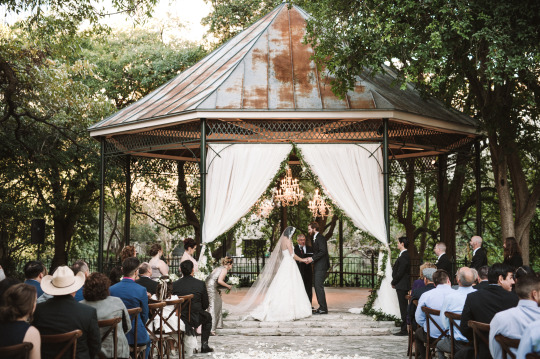
11/19/16. Who knew that would now be my favorite day of the year. Most days you wake up knowing exactly how each second will more or less pan out. I'm that odd mixture of an organized person with unsystematic attributes. Everything is on my calendar, but sometimes it gets lost in translation.This day, 11/19/16, was most definitely planned. To the T. Not a single detail or minute was overlooked. But somehow... it was like the agenda was thrown out the window. We were so engulfed in this overwhelming amount of love that it felt like we were going to explode into a million pieces across the dance floor. What itinerary? We just floated from one room to the next. It sounds cheesy because it was. It was us. I had this reoccurring scene in my head... that I'd fall down the aisle or my dad would show up late. The ceremony turned out to be our favorite moment of the wedding. We just could not. stop. smiling. Our officiant calls my name. I don't think I looked at him once. "Repeat after me, with this ring I thee wed. Take it and wear it as a pledge of my love and as a symbol of all we shall share." At this point I'm staring into James's soul and the outside world is merely a blurred image and the only sounds are a collective blurb of white noise. My face is in this permanent ridiculous smile and somehow words began to form,"With this ring I thee wed... wait what was it?" Everyone laughs. I manage to finish my vows and we kiss a cold November kiss. (snaps of me butchering the vows below)

It was a chilly Saturday. Believe it or not, November in Texas can be unusually hot. 11/19/16 however, was not one of those normal humid Saturdays. So much so that we rented tall heat lamps for guests. It was nice and cozy and our hors d'oeuvres kept us warm. I wanted our menu to reflect my background. Specifically the large majority of guests ~aka~ mi familia who happen to be Mexican American with an obsession for good food. We started the night with poblano and mushroom empanaditas with avocado aioli, chicken bites wrapped in bacon and stuffed with a jalapeno, oyster nacho on a yucca chip with guacamole chipotle aioli and micro pico de gallo. That’s a mouthful, huh? Signature cocktail, pomegranate margarita.

Family and friends start making there way to the the chapel inside the Southwest School of Arts. I danced a slow rendition of Sweet Child of Mine with my father. He was a mess. Just looked like he was about to cry any second. He's a proud Mexican father. He's known around town as the guy to not screw around with. So watching him a bit vulnerable was well... pretty awesome. He can be so hard to handle sometimes. We are alike in many ways. One of which our taste in music, hence our oh-so-classy father-daughter dance.

James and I danced Emmylou by First Aid Kit. We knew the first time we heard the song as it randomly popped up that that was the song. We created our own playlist for the wedding and well... it was bomb AF. Hehe. No really, we are proud of our playlist. An interesting mix of Los Growlers, Father John Misty to Band of Horses, to Tupac and 90's rap, then back to Rilo Kiley and then some Elton John. And of course a good portion of Tejano and Selena to get the party going. It was so random, but probably the best playlist I've ever heard in my life because it reminded us of all our adventures. (a pretty giddy first dance below)
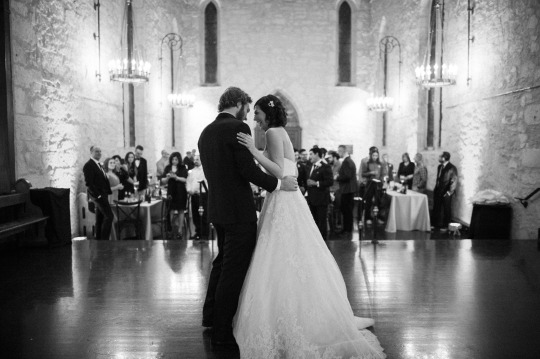
We had a seated dinner that consisted of wild field greens with roasted red and yellow bell peppers, corn, black beans, queso fresco, purple onion, salted pepitos, crispy red tortilla strips and cilantro lime vinaigrette. Instead of bread, we opted for a traditional warm masa cake with a chili lime butter rosette. The main entree was a ridiculously yummy beef tenderloin filet with cherry guava sauce, a trio of jumbo shrimp sauteed and topped with tequila (duh) lime cream sauce, in a shell with a lime, white cheddar, cilantro and green chile mashed potatoes, and seasonal grilled vegetables. Dessert.. dessert... Oh how I miss our dessert table. Traditional Mexican lady fingers and pan de polvo baked by a family friend in my hometown. We are pretty picky about our pan de polvo and hers are the best. Our wedding cake was made by Bird Bakery, owned by Armie Hammers wife, Elizabeth Chambers. She is native to San Antonio and opened this adorable bakery in Alamo Heights. Our cake was a smooth vanilla buttercream, no crazy decor or flavors. It was so rich and moist. Bird also baked Mexican brownies for guests with hints of cinnamon and spices. Last but not least...apple pies in mason jars (also by Bird). James was adamant that he did not want a grooms cake. He's been obsessed with apple pies since the day we met. The mix between traditional Mexican goodies and apple pies in mason jars was unintentionally symbolic of our merging of cultures & it gave us all the feels.


We ended the night with all of our friends lined parallel with each other holding hand painted maracas from Mexico (also a wedding gift). We ran through the crowd and jumped into our getaway car and took one big deep breath. We just laughed. Still in awe of what just happened. After a few drinks with some of our close friends, we called it a night. The next morning we hopped on a plane to Olympic National Park where we stayed in a cozy little cabin next to lake surrounded by mountains. BUT that's for another post. ;)


What people don't realize is that we have a lot of days like this. We are annoying, I’ll admit it. I used to hate those ridiculous couples that were so in love. I used to think, "what are they trying to prove" & "no one cares, please don’t send me a Christmas card." But here we are, obsessed. A good obsessed. When we first started dating, I'd argue it was more of a jealous obsessed, but man does time help evolve you. I'd like to think one of the best gifts in this world is allowing, watching, and seeing each other grow & I’m blessed that we do that for one another. We are not perfect, but we are one hell of a team.
Okay, less typing, more pictures.










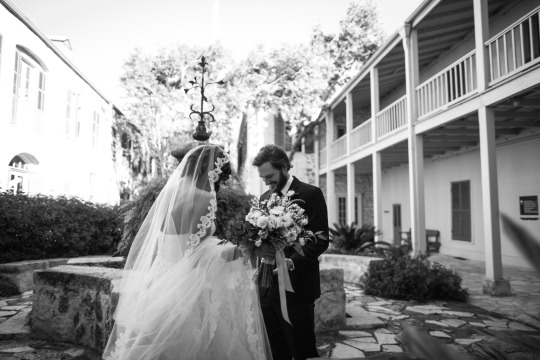



















@brides @theknot @liancarlodesign
3 notes
·
View notes
Text
Gov. Greg Abbott may be looking beyond Texas, as he runs even farther to the right
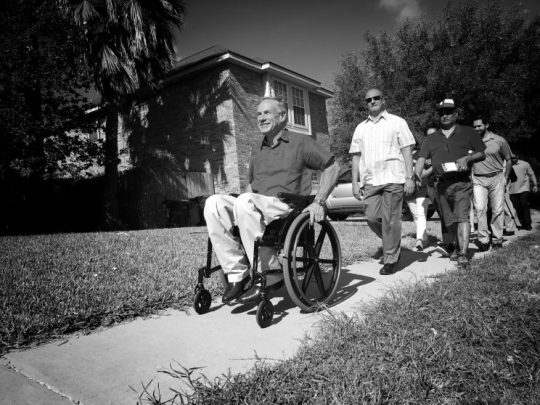
Texas Gov. Greg Abbott leads his staff on a neighborhood get-out-the-vote effort in McAllen, Texas, July 15. (Photo: Holly Bailey/Yahoo News)
McALLEN, Texas — It was not yet 10 a.m. on a recent Saturday morning when the doorbell rang. At first the man inside thought it was some Jehovah’s Witnesses calling, making their usual weekend rounds in his suburban neighborhood here in far south Texas.
But when he opened his front door, the man, who later introduced himself as Victor, seemed momentarily taken aback by what he saw. At least a dozen people, many with cameras and microphones, were crowding the tiny entryway of his modest brick home, while one photographer scrambled through the bushes like a wild animal to get a better vantage point. “The guy probably thinks we’re from Publishers Clearing House,” someone whispered.
But there were no giant checks, and no surprise jackpots. Just a man in a wheelchair right in front with big smile and a strong handshake, which he quickly offered up. “Hello,” he told Victor, grabbing his hand firmly. “I’m Texas Gov. Greg Abbott.”
It was officially day two of Abbott’s reelection campaign. Less than 24 hours before, the Texas governor had announced he would run for reelection in 2018. It was just a formality, though; the campaign had already been up and running for months, assembling the kind of political infrastructure not usually seen this early in a nonpresidential race. Abbott’s team has been working the ground game for months, canvassing neighborhoods across the state in what national party officials have described as one of the most advanced voter-targeting operations of any political campaign in the country.
And that’s how Abbott ended up here, rolling down Jasmine Lane in his wheelchair on a hot and sticky summer morning in one of the last remaining counties that still votes strongly blue in a flaming red state. While Abbott easily defeated his Democratic opponent Wendy Davis by 20 points during his race for governor three years ago, she trounced him here in the Rio Grande Valley by a margin as high as 30 points in some counties. It was a disappointing result for Abbott, who had visited the area dozens of times — more than Davis and more than any Republican before him — trying to make inroads with an electorate that is heavily Hispanic. It’s an issue that is personal for Abbott: His wife, Cecilia, a former teacher, is a third-generation Mexican-American, the granddaughter of immigrants.

Texas Gov. Greg Abbott and his wife, Cecilia, speak to a potential supporter. (Photo: Holly Bailey/Yahoo News)
The Rio Grande Valley was the first place Abbott visited after launching his first campaign for governor, and nearly four years later, it was his first stop again, even as he has pursued an agenda that has grown distinctly more conservative and, in some cases, some have argued, anti-Latino. But Abbott hadn’t given up trying to win over voters here. “I have a vision. I have a goal that I intend to achieve,” Abbott bluntly told a group of volunteers who had gathered to go knock doors on his behalf. “Whether it be this election or some election in the future, my goal is to ensure that in my lifetime the Rio Grande Valley is gonna be voting Republican every single election.”
Abbott’s campaign had chosen this block in particular, as it was home to what an aide described as “soft Democrats” — moderate, swing voters they believed could be convinced to support a Republican. Steering his wheelchair down a bumpy sidewalk, Abbott, who is partially paralyzed from the waist down, seemed more hopeful about his chances than decades of voting data would suggest. “You can’t get someone’s support unless you ask,” he breezily declared as he rolled toward the next house trailed by his wife, a contingent of staff and security and a scrum of reporters. “So we need to ask.”
Even before he arrived here, Abbott’s campaign was already in full force — so well organized that many outside Texas have taken notice, wondering if there isn’t more on the governor’s mind than trying to flip Democratic counties in the far southern part of his state. As of June 30, Abbott had nearly $41 million in the bank for his campaign, $10 million of which he’d raised in the last few days of the month alone. It was a near-record haul for any statewide candidate at this point in the race, even though he has yet to attract any major opponent and is widely regarded to be one of the safest gubernatorial incumbents in the country. A Morning Consult poll released this week named Abbott as the seventh-most-popular governor in the country, with a 64 percent approval rating among likely Texas voters.
Abbott’s popularity in a fast-growing state that is as strongly identified with Republican politics as California is for Democrats has already sparked whispers among GOP insiders always on the lookout for who might be worthy White House material. Abbott’s aggressive reelection campaign has only added to the speculation about whether the governor, emboldened in part by the example of Donald Trump, has higher ambitions than another four years in the Texas statehouse.
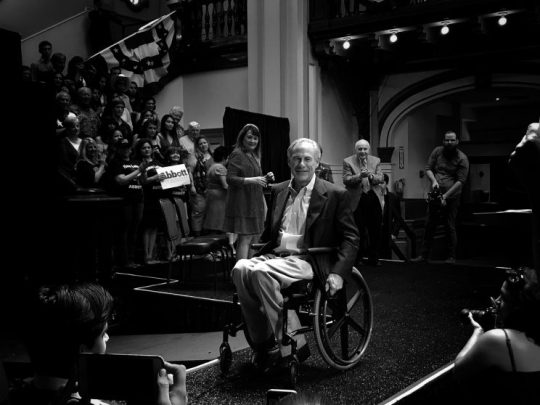
Texas Gov. Greg Abbott greets supporters after declaring his bid for reelection July 14 in San Antonio, Tex. (Photo: Holly Bailey/Yahoo News)
“I wouldn’t put him in the category of he goes to bed at night dreaming of being in the White House because he clearly is a guy who enjoys being governor of Texas,” said Bill Miller, an Austin-based lobbyist and political consultant who has close ties to Abbott world. But after Trump’s victory last November, Miller noticed a change: “I felt at that time his national antenna had gone up. He’s the governor of Texas, and in the political field, the person who is governor from Texas, the most conservative state, it puts you in the profile [of White House hopefuls]. I think he started thinking about it.”
Another longtime GOP campaign hand was less circumspect — though he declined to be named to speak more freely. “Abbott is from the land of George W. Bush and Rick Perry, who both ran for president,” he said. “You don’t think he’s looking at the White House right now and thinking he can do so much better?”
Abbott, a former Texas Supreme Court justice who spent 12 years as the state attorney general before becoming governor, has the strict conservative credentials that many Republicans used to require for those considering higher office — at least in the days before Trump. And he already has close relationships with the Koch brothers and other heavyweight conservatives who were viewed as Republican kingmakers before Trump’s unlikely campaign for president upended the 2016 campaign and shook up the party.
What is telling is that Abbott did not seem so outwardly surprised by Trump. Though he had endorsed Sen. Ted Cruz, a close friend and political ally who had worked for him as Texas’ solicitor general in the GOP primary, Abbott did not criticize Trump in the way many others in his party did. Perhaps that’s because he had already been embracing issues that came to animate Trump’s surprising political rise, including calls for stronger border security, a crackdown on so-called sanctuary cities and efforts to limit the resettlement of Syrian refugees in the U.S.
While Trump’s efforts to deliver on those campaign promises have been caught up in a mix of politics and legal wrangling in Washington, Abbott has continued to push forward with little opposition, raising the idea that Trump’s vision for America may ultimately be implemented by state executives like him, not the White House.
In May, Abbott signed a law banning sanctuary cities, which threatens local officials not only with stripped state funding but jail time and removal from public office if they do not cooperate with federal immigration authorities. Known as SB4, the bill also included a controversial provision that allows law enforcement officers to question the immigration status of people they detain.
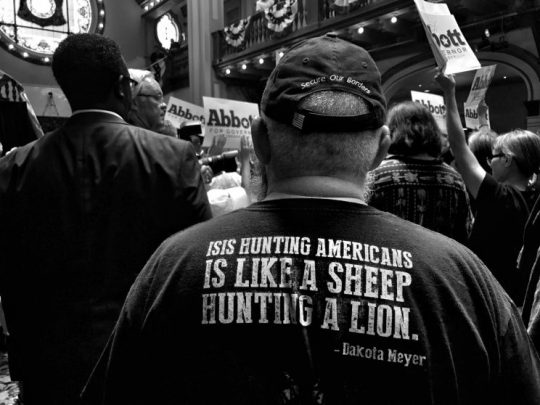
A supporter waits for Texas Gov. Greg Abbott to speak at his reelection campaign kickoff San Antonio, Texas, July 14. (Photo: Holly Bailey/Yahoo News)
Similar to Trump’s executive order signed earlier this year that sought to strip federal funding from sanctuary cities, the Texas law has prompted a flurry of litigation, including lawsuits from local governments including Texas’s four largest cities: Houston, Dallas, San Antonio and Austin. But unlike Trump’s order, which has been blocked by the courts and is currently under appeal, the law Abbott signed is set to take effect on Sept. 1, barring interference from the courts.
Abbott has seized on other issues that have been championed by Trump and energized his conservative base. He has argued against the resettlement of Syrians and other refugees in his state — though as governor of Texas he can do little but complain about what is largely a federal issue. And echoing Trump, Abbott has decried what he has described as “rampant voter fraud” across Texas, though only a few cases have actually merited prosecution so far.
Earlier this year, a Mexican national from Fort Worth was sentenced to eight years in prison for illegally voting in the 2012 and 2014 elections. The woman, who is a permanent U.S. resident and cast her ballot for Republican candidates including Texas Attorney General Ken Paxton, who prosecuted her case, said she believed she was allowed to vote and simply made a mistake. But Abbott pointed to her case as proof that “voter fraud is real and will be punished in the state of Texas.”
On some issues, Abbott is further to the right than Trump — though it’s unclear whether he is there out of personal conviction or the fear of being outflanked by other prominent Texas conservatives. That includes Lieutenant Gov. Dan Patrick, a fiery former talk radio host and tea party conservative from Houston who is the tonal opposite of the more restrained Abbott, who tends to operate with what a friend describes as a “judicial temperament.”
Their differences in style has led to criticism, even from Republicans, that Abbott has allowed Patrick too much control of the agenda in Austin. People close to governor insist he is leading, not following, but some also acknowledge the pressure Abbott has faced in keeping up with a party that has moved further and further to the right.
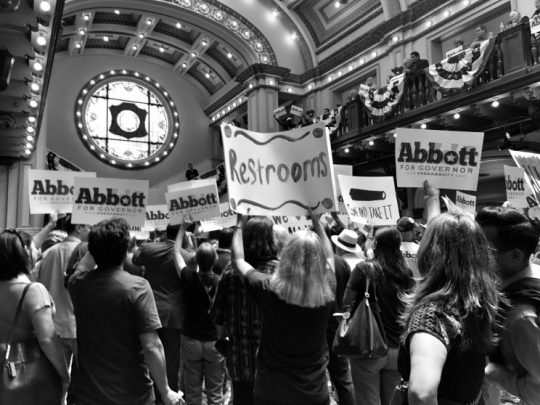
Supporters at Texas Gov. Greg Abbott’s reelection campaign kickoff, July 14. (Photo: Holly Bailey/Yahoo News)
“The biggest challenge for Abbott right now is the danger of getting flanked on the right, and he knows that,” a close ally of Abbott said. “And the atmosphere just keeps getting more and more conservative. You don’t think we can get anymore conservative, and then we do. And so he just has to keep going that way, to stay ahead of the needle.”
Abbott this week convened a special session of the state legislature to tackle unfinished business from last spring’s session, including the “bathroom bill” championed by Patrick that seeks to restrict which public restrooms transgendered Texans can use. The bill is modeled after a controversial law passed by North Carolina in 2016 and partially repealed by officials there earlier this year after widespread boycotts, including from the National Basketball Association, which pulled the All-Star Game out of Charlotte.
Abbott initially seemed to try to stay out of the fray as Patrick promoted the bill, which like the North Carolina law, has sparked threats of boycotts, including from the National Football League and dozens of corporations who have threatened to relocate jobs elsewhere. But he later signaled his support for the bill. When Patrick, who is head of the state Senate, failed to reach a deal with state Rep. Joe Straus, the moderate Republican speaker of the House, the governor called the state legislature back to work, with the bathroom bill as one of the leading agenda items.
Abbott has said the bill is necessary to clarify state law because of mixed signals from the federal government. But some in Texas have wondered if there are other political motivations at work. That includes persistent rumors that Patrick had considered a primary challenge against Abbott next year — something Patrick, who has announced his own bid for reelection, has repeatedly denied.
The Texas governor launched his reelection bid against the backdrop of the special session in what seemed to be a move to raise his public profile. In a shift, he’s threatened to publicly shame Republicans who break with his agenda, suggesting he might campaign against them next year — a move that was cheered by his most conservative supporters. He’s become more active on social media including Facebook and Twitter — where, like Trump, he seems to be trying directly engage and energize his base.

Texas Gov. Greg Abbott speaks to campaign volunteers in McAllen, Texas, July 15. (Photo: Holly Bailey/Yahoo News)
Asked about the ground game and fundraising, Abbott aides say the governor will eventually attract an opponent, and they want to be ready. “If you don’t run a campaign, you can’t win … whether we have a serious opponent or not,” said Dave Carney, a New Hampshire-based political operative who worked for Rick Perry before he signed as a senior advisor to Abbott.
On the stump, Abbott has been urging voters not to be complacent. In his announcement speech and later to supporters in McAllen, Abbott also cited concerns about an increasingly energized Democratic base in Texas — pointing to Trump’s 9-point win over Hillary Clinton in November, the smallest margin of victory for a Republican presidential candidate in 20 years.
Though they have worked hard for years to make inroads into what has unquestionably become one of the reddest states in the country, many Texas Democrats believe their party is still far from winning back significant ground in the state. Democrats haven’t held a statewide office in Texas since 1994 —the longest record of any state in the country. But you’d never know that listening to Abbott.
“Liberals are trying to mess with Texas,” the governor said in his announcement speech, pointing to places like Harris County, which includes Houston. He won there three years ago, but it went decidedly blue for Clinton last November, handing victories to other state and local Democrats on the ticket. Political observers cite changing voter demographics, including a growing Hispanic population that is expected to outnumber Anglos in the state within a few decades, and the influx of new voters from states like California, drawn to Texas by lower taxes and strong economic growth.
But Abbott attributed the results to outside forces like George Soros and House Democratic leader Nancy Pelosi — the familiar bogeymen for the right whose mere mention elicited loud boos from the governor’s supporters. “Liberals think they have found cracks in our armor,” Abbott warned.
As he spoke, a supporter waved a handmade sign that had been distributed by Abbott’s campaign, depicting a cannon that said, “COME AND GET IT.”
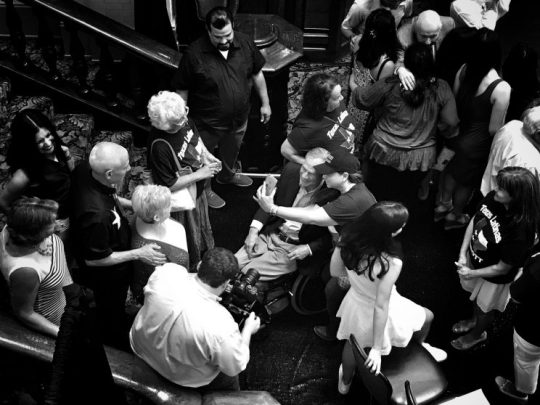
Texas Gov. Greg Abbott with a supporter in San Antonio, Texas, July 14. (Photo: Holly Bailey/Yahoo News)
The next morning, rallying supporters at a barbecue restaurant in McAllen, Abbott issued a similar warning. “We’re fighting for something that the liberals are trying to take away. And that is the freedom that Texas stands for,” he said. “If we were to lose Texas to the liberals, there would be no other place in the United States for people to go to for freedom. If we lose Texas, we lose America.”
Beyond Abbott’s conservative bona fides, he has a personal story that likely would play well on the national stage. In 1984, after graduating from Vanderbilt Law School, Abbott, who grew up in East Texas, moved back to Houston, where he had landed a job at a tony law firm. One day, while taking a break from studying for the bar, he went for a run and was jogging past a towering oak tree as it crashed to the ground.
A nearby Cadillac was flattened, and so was Abbott’s spine, nearly killing him. He was hospitalized for months and left paralyzed from the waist down. Doctors rebuilt his vertebrae piece by piece along with steel rods in his back.
When Abbott tells the story on the trail, he tries to do so with a little humor, telling voters that politicians promise all the time that they will have a spine of steel. “I really do have a steel spine,” the governor jokes.
Abbott’s disability makes him unusual — especially in Texas politics, where politicians are known for their swagger. But observing him, one quickly gets the sense that Abbott’s injury also motivates him to demonstrate his will and stamina. He operates with the air of someone who has something to prove.
Not by coincidence, the Texas governor kicked off his reelection on July 14—the 33rd anniversary of his accident. Though he made no mention of the date, Abbott rolled up a ramp to a specially lowered lectern, where he maneuvered around the stage shaking hands before delivering a 25-minute speech. Afterward, he worked the crowd longer than most politicians would, spending another 30 minutes posing for photos, leaning in for hugs and shaking the hand of everyone who approached him. He stayed until the very last supporter had cleared the stage, and then he rolled down a ramp and climbed into a waiting car on his own.
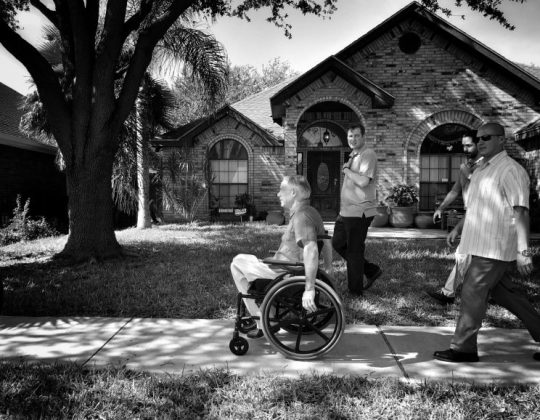
Texas Gov. Greg Abbott campaigning in McAllen, Texas. (Photo: Holly Bailey/Yahoo News)
It was a striking image compared to how aides to Franklin Delano Roosevelt discouraged and even outright forced reporters to refrain from showing the president, who had lost the use of his legs as a result of polio, in a wheelchair. Though Texas media has reported extensively on Abbott’s disability, some voters are still surprised to discover the governor’s paralysis.
During his get-out-the-vote effort in McAllen, Abbott rolled up the driveway of a Korean War veteran who was stunned to see the governor in a wheelchair. All the times he’d seen him on television, “I didn’t know you were paralyzed,” the man said, as he patted Abbott several times on the leg —explaining that was how troops would greet and honor comrades who had lost limbs in conflict. “Nice to meet you too,” the governor said.
Abbott’s political identity in Texas has been defined just as much by his willingness to take on Washington in the courts. Texas sued the Obama administration 48 times between 2009 and 2016, according to a tally by the Texas Tribune — with most of those lawsuits filed by Abbott himself. When he was running for governor in 2013, Abbott famously described his average workday: “I go to the office, I sue the federal government, and I go home.”
But having Trump in the White House has made it trickier for Abbott to present himself as a relentless warrior against Washington. Many of the regulations that he filed suit over, including rules from the Environmental Protection Agency, are in the process of being dialed back by the Trump administration, which means Abbott has less to complain about.
On the campaign trail and on the job, he rarely mentions Trump. In a radio interview earlier this week, he offered a rare critique of Trump’s performance so far, suggesting the White House needs some legislative accomplishments. “It’s like going through the first half of a football game without scoring a touchdown,” he told Austin’s KOKE radio. “You have to start putting some points on the board.”
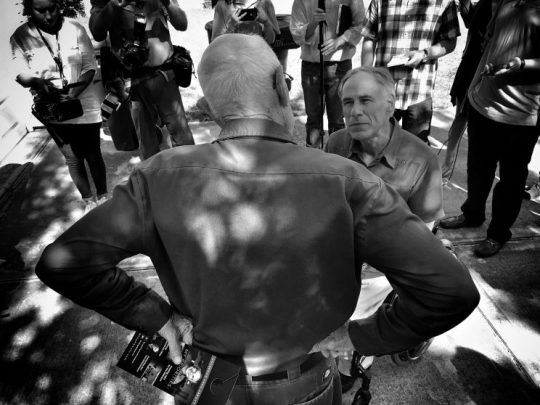
A man speaks to Texas Gov. Greg Abbott during a get-out-the-vote effort in McAllen. (Photo: Holly Bailey/Yahoo News)
But there are tensions. Last month, Paxton, the state attorney general and a close ally of Abbott, threatened to sue the Trump administration if it did not act to rescind a 2012 program approved by President Barack Obama that granted temporary work status to so-called dreamers — young undocumented immigrants who came to the U.S. as children.
The letter, which was co-signed by nine other Republican state attorneys general, called on the Trump administration to immediately cease processing new enrollees into the program and renewals. It came as Trump has publicly agonized over program — the fate of which he will personally decide, he told reporters on Air Force One last week.
At the same time, Abbott continues to champion one of his pet projects: a call for a new constitutional convention. Among Abbott’s proposals is an amendment that would allow a two-thirds majority of the states to override a Supreme Court decision and one requiring Congress to balance the federal budget.
Asked earlier this year if he still thinks a convention of states is necessary under Trump, he told reporters, “What is ailing America is far bigger than what any one president can fix.”
For the better part of an hour, Abbott rolled from house to house in McAllen, dodging low-hanging tree limbs and occasionally jetting into the street to avoid cracked sidewalks and driveways blocked by cars, as his entourage ran to keep up with him. Along the way, he stopped at five houses, cold calling on residents who seemed stunned to see the governor of Texas on their doorstep, asking for their vote. “I wish I had makeup on,” one woman told him. “But yes, you’ve got my vote.”
Even Victor, a Latino factory worker and registered Democrat, was won over, telling Abbott he backed his efforts to create jobs. “You’ve got my support,” he said.
Abbott aides have insisted their boss is focused on his reelection race and not beyond — and that his more immediate goal, in addition to winning a second term, is to expand the GOP’s power in places like the Rio Grande Valley.
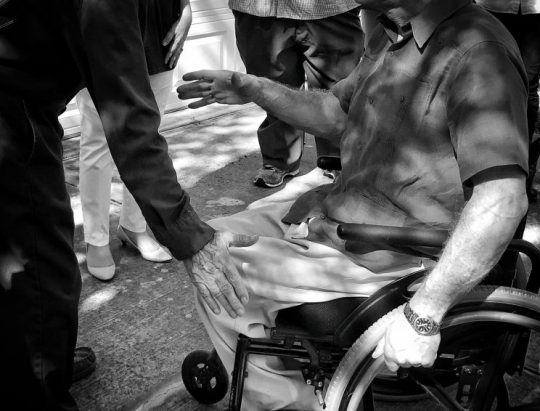
A man pats Texas Gov. Greg Abbott’s leg during a get-out-the-vote effort July 15 in McAllen. The voter told Abbott he had never realized he was paralyzed. (Photo: Holly Bailey/Yahoo News)
“I honestly don’t think he has ambitions to go to Washington,” Carney said of Abbott. “I think he believes, and I’ve heard this privately and publicly, he has the best job there is in American politics.”
But Carney acknowledged he also didn’t see his former boss Perry running for president. “You never know, I guess,” he said. “But I just don’t think [Abbott] is driven by personal ambition in that way. He’s extremely ambitious and competitive about what he wants to get done, but it’s not personal ambition.”
By the time Abbott hoisted himself from his wheelchair into the backseat of a black car set to take him to another campaign event, he had gotten pledges from seven people to vote for his campaign, while some had even promised to volunteer. “Not bad,” he told his staff.
_____
Read more from Yahoo News:
News of John McCain’s illness broke during meeting to save GOP health care plan
Which health care bill are Republicans voting on next week? No one knows yet.
Kris Kobach pushes debunked theory on illegal votes: ‘We may never know’ who won
The not-so-radical Trump presidency
Photos: ‘Gaza Girls: Growing up in the Gaza Strip’ – Resilience in the face of adversity
#Greg Abbott#election#republicans#_revsp:Yahoo! News#_author:Holly Bailey#_lmsid:a077000000CFoGyAAL#_uuid:a991127c-87cd-3cd8-a843-29727f4509fe#texas#governor
2 notes
·
View notes
Photo
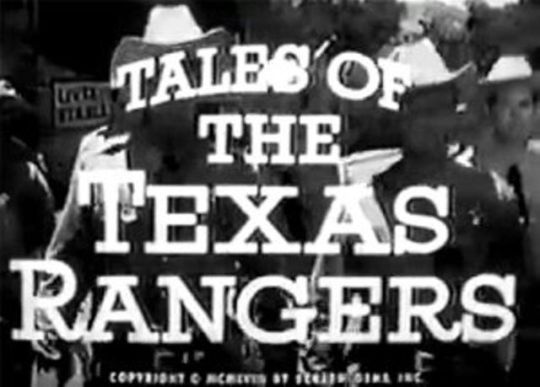
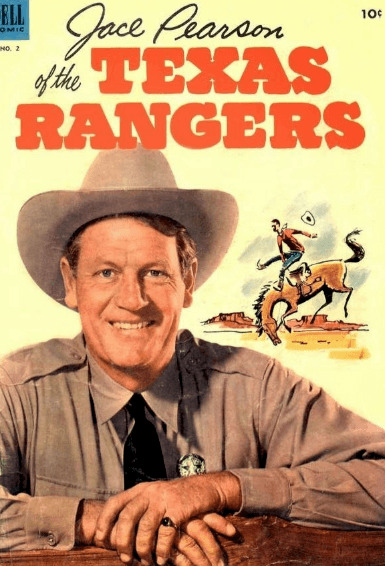
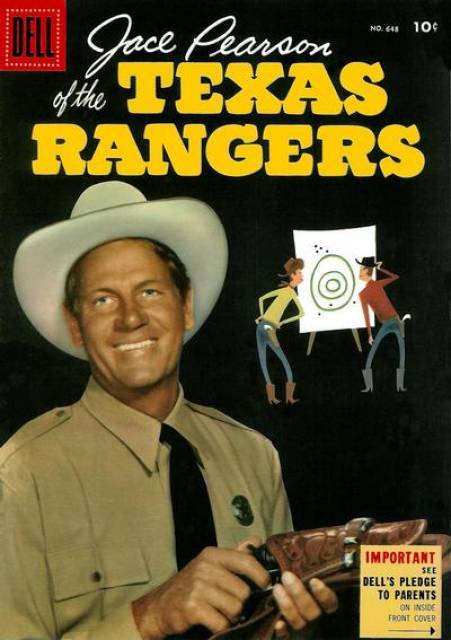
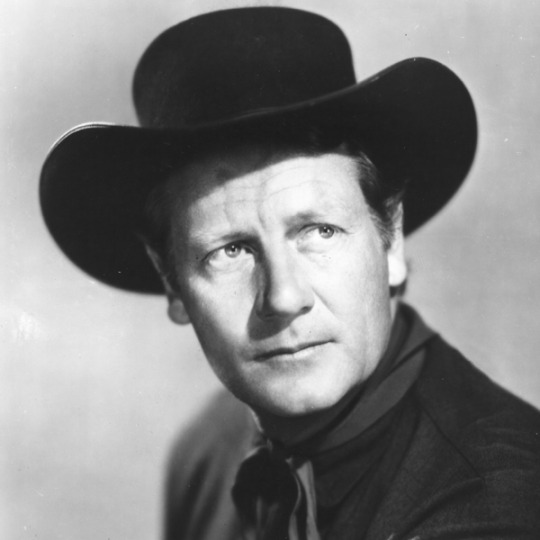
“Texas - more than 260,000 square miles - and fifty men who make up the most famous and oldest law enforcement body in North America!”
In the Golden Ages of Radio and Television, police dramas and Westerns ruled the airwaves. Some shows successfully combined these genres into a single program; Gunsmoke grew out of CBS’ desire for a “Philip Marlowe in the Old West,” and Have Gun - Will Travel offered a private eye whose beat was the post-Civil War West. One series combined the classic cowboy hero with a 20th century forensic approach to crime solving, sort of a Dragnet with spurs. That show was Tales of the Texas Rangers, which enjoyed a nearly 100 episode run on NBC radio before heading out to ride the television trail. That radio run began on radio on July 8, 1950.
The Rangers had a long reputation as iconic lawmen of the west. The group was created when Stephen Austin recruited a small cadre of men to protect settlers in the territory following the Mexican war for independence from Spain in 1823. When Texas became a republic, the Rangers fought off Native Americans and took part in battles during the Mexican-American War. Following a brief suspension during the Civil War, the Rangers were reassembled in 1873 and their reputation (and legend) took shape in the hearts and minds of Texans. They fought Indians and chased outlaws. Among the notable criminals caught (and killed) by Rangers were bank robber Sam Bass and the legendary Bonnie and Clyde (as recently dramatized in the terrific Netflix movie The Highwaymen).
Producer/director Stacy Keach (father of Mike Hammer star Stacy Keach, Jr.) initially envisioned a feature film based on the exploits of the Texas Rangers but he shifted his focus to a radio series. At the time the series premiered, there were only 50 Rangers on duty, adding to the mystique of the frontier lawman. Keach explained the job of the Rangers was “to solve major crimes using known scientific devices, old-fashioned tracking techniques, and psychological analysis."
Like Jack Webb and the Los Angeles Police Department in Dragnet, Keach had to obtain the cooperation of the Texas Rangers. Each script required official approval from the Rangers’ office. Fortunately, Keach and his writers found a patron and a muse in Captain M.T. "Lone Wolf” Gonzaullas, a 30 year veteran of the Rangers who claimed to have killed 31 men during his time on the force. Keach said twenty percent of the stories produced on Tales of the Texas Rangers came from Gonzaullas’ personal experiences. As Keach recalled later, “[Gonzaullas] never could remember our writers’ names, but he could recall names, dates, and places of every case he had ever worked on." His cooperation allowed Keach and his team access to Ranger case files and interviews with the men behind the legends. Some case reports were brief, but colorful. Examples included "Shot all to pieces, but not serious,” and “Had a little shootin’ match. They lost.”
The series found its star in an actor who was entering his third decade in show business. Joel McCrea started in Hollywood in the late 1920s as a stand-in for some of the stars of the silent film era, including Rudolph Valentino. He got his first major movie role in 1934 and embarked on a career as a leading man. McCrea starred in films from Preston Sturges (Sullivan’s Travels) and Alfred Hitchcock (Foreign Correspondent), but admitted he felt most comfortable in the Stetson and spurs garb that Westerns offered.
“I liked doing comedies, but as I got older I was better suited to do Westerns. Because I think it becomes unattractive for an older fellow trying to look young, falling in love with attractive girls in those kinds of situations. Anyway, I always felt so much more comfortable in the Western. The minute I got a horse and a hat and a pair of boots on, I felt easier. I didn’t feel like I was an actor anymore. I felt like I was the guy out there doing it.”
McCrea lent a tough, no-nonsense air to the lead role of Ranger Jayce Pearson. He’s Joe Friday with a touch of Gary Cooper; Wyatt Earp with a radio and forensic knowledge.
The series premiered on NBC, the home of Dragnet, and featured many of the same supporting actors who popped up on that Jack Webb series, including Parley Baer, Stacy Harris, Tony Barrett, and Barney Phillips. Keach also employed some of the same sound effects crew from Dragnet. While the soundscapes for the two shows were very different, both benefited from a very real, authentic sound to the proceedings. Hoofbeats, footsteps on rocky terrain, lonesome train whistles, and the sounds of the prairie were commonplace and helped to ground the series as docudrama.
Though it had a relatively short run (another radio series that arrived on the wrong end of television’s debut), Tales of the Texas Rangers is a unique entry in the world of radio detectives. As a then-present day Western, it was a rarity in and of itself, but the combination of cowboy justice and methodical police work (backed up by taut scripts and production values) makes it worth a listen to audiences today.
16 notes
·
View notes
Photo


Welp, I did it
Behold, Human!AU Snack Pack, they are essentially the theater clique at their high school.
I have made the... very regrettable mistake of trying to use watercolor pencils on non-watercolor paper and let me tell you all it was a PAIN
But I got it done and here it is
Let’s learn a little about them, shall we? (HUGE shout out to @jammiehamato for throwing together a ton of headcanons for everybody!! I implemented a lot of them into this!! There are also some headcanons inspired by @chasinthecloudsaway and their fanfiction)
Suki Mendoza
-Half Filipino, Half African-American (first generation American on father’s side)
- Bisexual
- Has known Poppy and Branch since Kindergarten school, one of Poppy’s closest friends, one of the few people Branch can tolerate at his worst
-Has trouble finding her inside voice, tends to speak really loudly
-Dance is her main form of exercise and she’s really good at it, her secondary form of exercise being basketball (she’ll 2v2 with Branch, Guy, and Satin, or 5v5 on a team with Branch, Guy, Satin, and Smidge)
-Models for Satin and Chenille’s Etsy page
-When she gets passionate about something she’ll start speaking in rapid-fire Tagalog
Creek Sinclair
-Immigrant from Great Britain (came to America during middle school)
-Heterosexual
-Met Poppy and the rest of the Snack Pack during their freshman (his sophomore) year of high school (second to last member of the Snack Pack, only Gristle is newer than he is)
-Excels in science classes (physics and biology being his strong points)
-Teaches yoga to the Snack Pack (attempts to teach it to Branch) and is often found stretching or meditating before school hours
-Has a superiority complex and always tries to give off the illusion that he’s on the moral high ground (will antagonize others)
-Also no longer a member of the Snack Pack after being dumped by Poppy
Popi “Poppy” Hanako
-Japanese-American (second generation American on both sides, her grandparents from both sides came to America around the same time)
-Pansexual
-Friends with her neighbor, Branch, essentially since birth (their families were good friends prior to either of them being born)
-Tries to befriend everyone and everything. She often has to be stopped from feeding wild animals. That being said, a lot of critters, birds, and strays will follow her around because she feeds them
-Fills scrapbook after scrapbook after scrapbook with all the events of her and her friends’ lives (carries around one of those instax instant cameras just for this purpose)
-Crushes really easily and really hard, but never dated until Creek came along
-Plays many instruments, but her go-to instrument is the guitar
Brandon “Branch” Figaroa
-3/4 Mestizo, 1/4 Black-Latino (prefers the term “Mixed Latino” or just “Latino” because his entire family is from Latin America) (first generation American)
-Bisexual
-Friends with his neighbor, Poppy, essentially since birth (their families were good friends prior to either of them being born)
-Had a below-the-knee amputation when he was five years old due to a car crash that crippled him and killed his parents. He has a prosthetic left leg. (He actually has three different types of prosthetic legs by the time he’s in high school (and done growing), one that he wears nearly all the time, a waterproof one for swimming, and a more realistic-looking one that he only wears on very special occasions (like his performance in the school musical, “Aida”, because he couldn’t cover his legs with pants) because it’s expensive and he doesn’t want to scuff it up by wearing it all the time)
-Usually ends up socializing with other people ONLY because Poppy drags him along, is very emotionally dependent on Poppy
-Incredibly talented at poetry, writing, and songwriting, but usually too self-conscious to share it with the world
-Played the violin since middle school, was in middle school orchestra
Bridget Garcia
-Mexican-American (second generation American, doesn’t know Spanish)
-Heterosexual
-Met Poppy and the Snack Pack so far in sixth grade, when they helped her find the confidence to audition for the school talent show, she’s also a very close friend to both Poppy and Branch
-Moved from Austin, Texas to San Francisco, California at the end of fifth grade
-She grew her hair out in eighth/ninth grade, with Poppy’s encouragement to do so
-Pastel is her a e s t h e t i c (so is disco/70′s memorabilia) and her room and closet reflect this
-Gristle is, in her opinion, the most beautiful guy on earth, and had a crush on him ever since she moved to California, but never told anyone until sophomore year of high school (and, of course, once she tells the Snack Pack, they come up with the most elaborate scheme to get them together, which ABSOLUTELY involves a pink jumpsuit, an ungodly amount of colored hairspray, and an earpiece for them to relay things to say to her)
Gary “Gristle” King, Jr.
-White American
-Heterosexual
-Joined the Snack Pack when he and Bridget started dating in sophomore year of high school, but had known Branch as his tutor for a few years prior
-Got his nickname for being exceptionally greasy (his undying love for pizza doesn’t help this at all). He not only accepts, but embraces this nickname because he doesn’t know why he has it or how he earned it, he just thinks it’s so cool that he has nick name.
-Does not do well in academics, but really loves, and is really good at dancing and rollerskating, instead.
-Just like Poppy, he tries to befriend everyone and everything, and he’s actually generally well-liked because of this
-Thanks to this

quote from the art book, Gristle is that guy who still wears the same clothes he grew out of in middle school, haha. (I mean, one doesn’t really grow much, after high school)
Sadie “Smidge” and Felipe Roberto
-Identical twins (Smidge is a transgirl, and chose her name, but “Smidge” was a nickname she’s had since before she came out)
-Of Puerto Rican descent (third generation American, their grandparents were New Yourican, they don’t know Spanish)
-Asexuals
-Became friends with Poppy and the Snack Pack so far in fourth grade
- Felipe is mute and mostly uses a dry-erase board to talk to others (Poppy always gifts him with new dry-erase colors to use) but uses ASL to talk to his sister. If he doesn’t have his dry-erase board handy, Smidge translates from ASL so people who don’t know ASL can understand him
-People also sometimes affectionately call him “Scuzz” or “Fuzz” because he almost always grows his hair out, he hates having it cut
-Smidge LOVES sports and weight lifting and can usually be found at the gym. She will also fight anyone who hurts her friends (people are scared of her)
-They are the shortest people in their high school, at just 4′7″
Benjamin “Biggie” Denver
-Immigrant from Great Britain (came to America in fifth grade)
-Homosexual
-Poppy and the Snack Pack so far befriended him on the first day of school, because he was shy and didn’t seem to have any friends, yet
-Mr. Dinkles is his therapy pet chihuahua that he spoils to BITS and all his collars are rhinestone studded and if he’ll bring him wherever he can get away with bringing him (his biggest enemies are “no dogs allowed” signs)
-He strives to one day be a pet photographer and volunteers at the local animal shelter to take pictures for their website
-He’s very good at comforting the other members of the Snack Pack, and is usually the one to talk Branch down from his depressive episodes
-He carries around his digital camera all the time, and usually helps Poppy fill her scrapbooks by emailing her the pictures he’s taken
Guy Dihrati
-Indian-American (first generation American)
-Pansexual, but most people mistake him for homosexual
-Met Poppy, Branch, and Suki in third grade (he had already been friends with Cooper)
-Will only wear things that either already have glitter or sequins on them, or can have glitter or sequins added to them (and, of course, even his hair has glitter in it)
-If he had a higher pain tolerance, he’d get more piercings than just his ears
-He’s self confident to the point where he can borderline on narcissistic
-He and Suki become best friends, and people would think they were dating if they didn’t already think that he’s gay. They can usually be found hanging out with each other and playfully teasing Branch and Poppy (usually Branch) because of how openly cuddly they are. They’re basically capable of grade-school levels of humor, but it’s endearing, all the same
Cooper Laboy
-African-American
-Homosexual
-Met Poppy, Branch, and Suki in third grade (he had already been friends with Guy)
-Before getting his tattoos at the age of 16, he would often draw on his arms with pen, and sometimes, he’d end up with really elaborate designs that would unfortunately wash off in the shower
-He is so very passionate about dancing! He also is the theater teacher’s aide and helps choreograph for the school musicals (and, in the future, for the theater workshop Poppy runs in the summers)
-He has a different bow-tie everyday, and has drawers at home just full of them
-People try to challenge him to rap battles, he always wins
Shuchun “Satin” and Xuilan “Chenille” Wu
-Identical twins
-Immigrants from (formerly British) Hong Kong (Satin and Chenille are their chosen American names) (They came to America in fourth grade)
-Satin is heterosexual, Chenille is homosexual
-They became friends with Poppy and the Snack Pack so far in fifth grade (and tbh Chenille had a crush on Suki ever since)
-They run an Etsy store where they sell outfits they sewn
-They absolutely ABHOR how blandly Branch dresses, and will sometimes try to drag him off to go clothes shopping, despite his protests (once they get his measurements for costuming in the school musical, they try to sew him new clothes)
-They run costuming and makeup for the school productions (and, in the future, for the theater workshop Poppy runs in the summers) and do so in tandem to performing in said productions
-They’ll braid their hair together when they’re bored, they’ve done so ever since they were small children
Holy Hell this took me five hours to write. I hope you like it!!
#dreamworks trolls#snack pack#human au#josiemod draws#trolls#this took me two goshdarned weeks to draw
512 notes
·
View notes
Text
New on Sports Illustrated: The Background That Shapes Dave Aranda, Baylor's New Head Coach
Quiet and cerebral, the Bears' hire has a defensive mind and a Mexican heritage few know about.
Dave Aranda misses the tamales. While others feast on the usual American holiday treats—turkey and gravy, mashed potatoes and green been casserole—Aranda and his family ate tamales. And a lot of them. “It’s weird having Christmas without tamales,” he says in an interview last month with Sports Illustrated. “I would be crushing tamales throughout the lead up to Christmas.”
Baylor’s new head football coach is unique in many ways. Aranda was one of the most unusual longtime defensive coordinators in college football—quiet and cerebral, not a yeller or screamer. He never even played college football, and he originally wanted to enlist in the Navy. But nothing separates Aranda from others in the high-profile coaching fraternity more than his heritage—he’s Mexican American.
Decades after being raised as a Spanish-speaking child in southern California, Aranda landed his first head coaching job at a place with a sprawling Hispanic and Latino community deep in the heart of Texas. The nation’s highest paid assistant is now leading the Big 12 runner-up Bears, replacing Matt Rhule and ending a four-year stretch as LSU’s defensive coordinator. Three days after helping lead the Tigers to a national championship victory over Clemson in New Orleans, Aranda emerged as a top candidate at Baylor, a move SI first reported on Thursday. It came only after the school flirted with Virginia Tech coach Justin Fuente and interviewed Cajuns coach Billy Napier.
So what are the Bears getting in Aranda? Many in the industry call him one of the game’s best defensive minds, a 43-year old who captained some of the most successful defensive units in football at LSU and before that for three years at Wisconsin. Because of his cerebral nature, Aranda developed a host of nicknames over the years, most notably The Professor and The Defensive Coordinator Whisper. He’s a football nerd who will often talk about the “math of football” while babbling in technical jargon. Aranda’s scheme is built around “dictating” the terms of the game, a more offensive and attacking approach to defense.
Aside from football, Aranda is a married father of three with a background that few know about: He’s a minority, a man who embraced his Mexican roots in an interview last month with SI. Aranda says both of his parents’ families originated from the Guadalajara area, a six-hour drive west of Mexico City. He grew up speaking a mixture of English and Spanish. Can he speak Spanish today? “Yeah. Cuss words,” he laughs. “That’s all I remember.” Aranda is the 12th minority head football coach among the 65 Power 5 teams, it is believed. He’ll reside in Waco, a place in which about one-third of the population is either Hispanic or Latino. It’s similar to back in his home of Redlands, Calif., a quiet community at the foothills of the San Bernardino Mountains about 60 miles east of Los Angeles.
Paul and Marguerite Aranda raised two sons, Dave and Mike, and both got into coaching. Mike is an assistant basketball coach in Redlands. The boys didn’t grow up in an affluent home. Marguerite worked in the social security office, and Paul was a member of a prison parole board. Dave remembers spending hours after school at the YMCA while his parents worked. “We didn’t have a lot of money,” he says. “I just remember all the different people that are hanging out at the YMCA during the day. There would be so many different groups of people: the head bangers, the people who would study, the jocks, there would be the Mexican guys who didn’t speak English. I knew all of those people and could talk to them. I was really quiet always but could talk to them all. I cherished that experience.”
Mike and Dave were both active in sports growing up, but Dave never got to live his dream as a college football player. A Wing-T guard and linebacker, Dave injured his shoulder as a sophomore, something that lingered for years. He has undergone six—six—operations to the right shoulder, he said, and it prevented him from not only playing in college but competing at linebacker in high school. He was moved to the O-line. Dave was tough, even playing an entire half of football after re-injuring the shoulder in a playoff game. Afterwards, doctors X-rayed the arm—he had broken his shoulder. “He was a tough kid. He never came out,” says Miguel Olmeda, Aranda’s coach at Redlands High who he’s still close with. “He’s nails. If he would have played linebacker, he would have gotten recruited.”
Dave often pokes fun at himself over one aspect of his high school days: He was a terrible student. He was too focused on football and film sessions, Olmeda says, rather than Algebra and Geometry. Aranda kept reams of notebooks from the high school film sessions, and Olmeda believes he still has them in his possession. “To this day, he has a spiral notebook at this time full of Xs and Os,” Olmeda says. “He wanted to be a college coach in the worst way.”
At the start, Aranda learned the game on his own, often using the library in California as a tool, pouring over books and jotting down notes. While a student at Cal Lutheran, he studied Philosophy while rooming with Tom Herman, the current Texas coach. Aranda served on the football staff, moving up from the videographer to a student position coach and then a graduate assistant. He spent much of the offseason during those years traveling to various college campuses learning and digesting football. He drove to Arizona State, UCLA and to San Diego to visit the Chargers. He visited Southern Cal, too, meeting with a Trojans’ defensive graduate assistant, a guy named Dave Doeren, and he met with USC’s defensive line coach. His name: Ed Orgeron.
A sponge for knowledge and an architect of defense, Aranda developed a reputation as a guru, but he didn’t make it onto a big stage until Gary Andersen hired him as defensive coordinator at Utah State in 2009. It was a risky move—Aranda and the entire Hawaii staff had just been fired. “It’s hard to be fired in Hawaii,” Aranda said in an interview in 2016. “It’s probably the hardest place to get fired, the time change and all. I think people kind of forget you’re up there. I’ve never been one to work the phones or call. You’re basically kind of sitting around with no one calling.”
Since then, his defense has taken many shapes. While based out of a 3-4, his units are multiple and ever changing, with a host of different packages, and at times, he uses an amoeba formation. “He definitely has a little more of an attacking style of defense, man to man with the corners in some fashion,” LSU safeties coach Bill Busch said in a previous interview. “He likes to figure out ways to change things up. He’s extremely multiple. He has a few different packages.” Years ago, Karl Scott, now an assistant at Alabama, called Aranda the “smartest coach I’ve been around.” The two worked together for a year at Delta State in 2007. In coaching circles, Aranda is most known for using what he calls “creepers,” a simulated blitzer and something he developed over the years with former boss Ron Roberts, now the defensive coordinator at Louisiana. Former longtime coach and current Big Ten Network analyst Gerry DiNardo says Aranda calls plays like an offensive coordinator, always attacking.
His personality is the opposite, a somewhat soft-spoken man with a calming, gentle presence—far removed from the red-faced, high-pitched ol’ ball coach usually found in the defensive coordinator position. Aranda is such a quiet guy that teammates on his high school team in Redlands referred to him as The Fencepost, says Olmeda. “As quiet as you think he is now, he was almost mute in high school,” Olmeda laughs during an interview last month. “He was a kid of few words.” One former colleague said of Aranda, “He’s like a ninja.”
Aranda describes his childhood as “a little bit like it’s another life.” His parents didn’t raise him on football by any means. They knew very little about the sport until now, Aranda says. In fact, during football camps as a child, Aranda was the oddball kid, the one wearing the jeans and dress shoes. “I didn’t fit. But I didn’t know,” he says. “I always think of that when we have camps. We’ll have camps and I’ll see someone that would be me. I always spend time with them. It reminds me of my own experience.”
And now here he is, a Power 5 head coach, a minority with one of football’s biggest jobs. He’s prepared for this for years. “Bottom line,” he says in an interview last month, “is always be yourself.”
January 17, 2020 at 06:18AM
The Background That Shapes Dave Aranda, Baylor's New Head Coach
from Blogger https://ift.tt/35ZIX7a
0 notes
Text
Pancho Villa, prostitutes and spies: The U.S.-Mexico border wall’s wild origins
By Michael E. Miller, Washington Post, January 10, 2019
On an August afternoon in 1918, a mysterious man approached the U.S.-Mexico border in the bustling town of Nogales.
For decades, the boundary between the two countries had been little more than an imaginary line in the sand, marked only by the occasional--often crumbling--pillar in the Sonoran desert. But rampant smuggling, the Mexican Revolution and the outbreak of World War I had split the border town in two, sowing fear and stoking tensions.
As the man walked toward Mexico, where Mexican soldiers were waving him on, a U.S. Customs inspector suddenly ordered him to halt.
Unheeded and suspecting the man was a smuggler, the customs inspector drew his gun.
So did two American soldiers, one of whom would later say he thought the man was one of the many German spies rumored to be trying to draw Mexico into war with the United States.
Yards away, Mexican officials also shouldered their rifles. When one fired, hitting an American soldier in the face, both sides of the border erupted in gunfire.
“A battle breaks out, killing 12 people, including the mayor of Nogales, Sonora,” said Rachel St. John, a history professor at the University of California at Davis who wrote about the incident in her 2012 book, “Line in the Sand: A History of the Western U.S.-Mexico Border.”
The two-hour shootout marked the end of an era of easy movement across the boundary in Nogales, she said, as Mexican and American officials quickly agreed to put up a six-foot fence through the middle of the border town.
Today, the fence is now a 20-foot-high row of steel beams, recently reinforced with razor wire.
As President Trump travels to the border Thursday to demand $5.7 billion funding for a wall, his high-stakes visit draws attention to the past century of wild, often unsuccessful efforts to fortify the U.S.-Mexico frontier.
Long before the perceived threat was Central American asylum seekers, it was German spies and Mexican revolutionaries, prostitutes and polygamists, Chinese immigrants and cattle infected with “Texas fever.”
“The border between Mexico and the United States is not just a line on a map,” wrote sociologist Douglas Massey in a 2016 essay. “Rather, in the American imagination, it has become a symbolic boundary between the United States and a threatening world. It is not just a border but the border, and its enforcement has become a central means by which politicians signal their concern for citizens’ safety and security in a hostile world.”
Given this outsized importance, Massey wrote, it is easy to forget that the U.S.-Mexico border didn’t exist at all until 1821, when Mexico gained independence from Spain. And it wasn’t for another 30 years that the boundary line looked anything like it does today.
Texans revolted against Mexico in 1836, largely to preserve the institution of slavery, according to Massey. When Texas joined the Union in 1845, it led to a war between the United States and Mexico that ended with American troops occupying Mexico City. At gunpoint, Mexico signed away what is now Arizona, California, Nevada, New Mexico, Utah and Colorado for $15 million. Five years later, in 1853, the United States bought another 30,000 square miles for $10 million so that it could build a transcontinental railroad.
If the two treaties fixed the U.S.-Mexico border on a map, they did little to clarify things on the ground.
By the end of the century, the boundary was blurred beyond recognition. Markers had been moved, destroyed or vandalized. Towns had sprung up on the border. In Nogales, saloons straddled the border, selling Mexican cigars on one side and American liquor on the other, both duty free, St. John wrote.
In 1882, the United States and Mexico formed a joint commission to resurvey, remap and remark the border. The team found that in one stretch, there wasn’t a single marker for 100 miles.
On the commission’s recommendation, President William McKinley ordered a 60-foot swath cleared along the Nogales border in 1897. Saloons were destroyed or moved. Ten years later, the order was extended to all of Arizona, New Mexico and California.
As the border began to take shape, officials started to restrict who and what moved over it. In 1909, Congress passed the Act to Prohibit the Importation and Use of Opium for Other than Medicinal Purposes, effectively launching the business of drug smuggling on the border, St. John writes.
That same year, the first federally built fence went up along the border in Baja to prevent American cattle from contracting “Texas fever”: a disease spread by ticks that had been nearly eradicated in the United States but persisted in Mexico.
Around the same time, customs officials began to prevent the entry of certain people into the United States.
“While Mexicans and Americans moved freely back and forth across the boundary line, by the late nineteenth century a series of new U.S. laws restricted a growing number of immigrants from crossing the border,” St. John wrote. “The U.S. Congress passed the first law restricting immigration--specifically that of convicts and prostitutes--in 1875. By 1910 new legislation had added Chinese immigrants, lunatics, people likely to become public charges, contract laborers, polygamists, anarchists, and others deemed undesirable to the list of excluded groups. This legislation turned what had been an innocent movement of people into illegal immigration.”
The Bureau of Immigration was created at the turn of the century to crack down on all types of illegal entries, but its 18 agents were so consumed with catching undocumented immigrants from China that they quickly became known as “Chinese inspectors,” according to St. John.
Sophisticated smuggling networks soon developed along the border, including doctors specializing in removing “signs of disease,” corrupt officials and rail cars full of Chinese immigrants.
“Fences actually work way better for cattle then they do for humans,” St. John told The Post.
By the early 20th century, the border had become recognizable--if still easily crossed without detection. But that began to change with the outbreak of the Mexican Revolution in 1910.
As Mexican revolutionaries plotted from American hotels and battles spilled over the border, the United States struggled to remain neutral. Several American sentries were killed by stray bullets and refugees began flowing north. Both Mexican bandits and soldiers started raiding towns in the United States.
During the Battle of Sonora in 1914, the fighting came so close to the border that U.S. troops marked the boundary line with American flags to prevent it from spilling over, according to St. John.
It didn’t always work. On March 9, 1916, after the United States broke its neutrality by supporting one of Pancho Villa’s rivals, the Mexican general retaliated by raiding the border town of Columbus, N.M. Although Villa lost more than 100 men, compared to 17 Americans, one local described the scene as a “holocaust.”
“Main Street was in chaos,” Mary Means Scott recalled, according to “Line in the Sand.” “Men were frantically digging in the smoldering ruins for bodies. Others looked distractedly at yesterday’s places of business, now blackened junk.”
A week later, Gen. John “Black Jack” Pershing led an armed expedition into Mexico to catch Villa. The pursuit lasted for almost a year, and stoked Mexicans’ fears that the United States intended to annex its weakened southern neighbor.
As the United States was pulled toward entering World War I, American anxiety over the Mexican Revolution was compounded by fears of espionage along the border. In a telegram decoded by the Americans in early 1917, the German foreign secretary offered Mexico support “to reconquer its former territories.”
Two years earlier, a plot had been discovered to do just that, said Miguel A. Levario, a history professor at Texas Tech University and the author of “Militarizing the Border: When Mexicans Became the Enemy.”
“There was some concern that Pancho Villa would give an order and all the people of Mexican descent [in the United States] would overtake Fort Bliss,” Levario told The Post. But the so-called Plan de San Diego didn��t get very far before its alleged mastermind was arrested.
“When the guy was brought to trial, the judge thought it was such a ludicrous idea that he thought guy didn’t need jail time but rather a psychiatrist,” Levario said.
Still, fear lingered.
“If the people of Los Angeles knew what was happening on our border, they would not sleep at night,” the Los Angeles Times warned in April 1917, according to “Line in the Sand.” “Sedition, conspiracy, plots and intrigue are in the very air. The telegraph lines are tapped, operators have been seduced with gold and spies come and go at will.”
This was the atmosphere on the afternoon of Aug. 27, 1918, when the mysterious man approached the border in Nogales.
“We still don’t know who he was,” St. John told The Post. “Maybe he was a spy. Maybe he was a smuggler.”
What was clear was the response, as Mexico and the United States agreed to erect a six-foot fence.
Other fences went up along the frontier around the same time. Near the border between Calexico and Mexicali a year later, two U.S. soldiers fatally shot a Mexican man named Alfredo Valenzuela only for investigators to find they weren’t sure in which country the killing had occurred.
“To determine if Valenzuela was shot on U.S. soil they had to call in an engineer to determine the location of the boundary,” St. John wrote. “Noting the need to clearly demarcate the boundary line given the heightened border controls, [Baja] Governor [Esteban] Cantú suggested the U.S. government build a fence to assure that its soldiers knew which side someone was on before they shot.”
Even after the end of World War I and the Mexican Revolution, some of the border fences stayed up, according to St. John.
“By the early 1920s, there are what look like permanent fences maintained by the government at most major ports of entry,” she told The Post.
Over the next century, these wood and barbed wire fences would be upgraded to chain link--including some from Japanese internment camps, according to St. John--and then, in the 1990s under both George H.W. Bush and Bill Clinton, to 12-foot metal sheets formerly used as helicopter landing pads during Vietnam.
Although these measures were met by local protests, they enjoyed broad bipartisan support. When George W. Bush signed the Secure Fences Act into law in 2006, authorizing the construction of 700 miles of new border fencing, 80 senators supported it including Hillary Clinton, Barack Obama and Charles E. Schumer.
Yet, St. John warned against equating fence-building a century ago to Trump’s demand for a wall today.
“When they were building fences in Nogales during the Mexican Revolution, it was a response to what was happening along the border,” she said. “That is not what is happening now. This [demand for a wall] is coming top down. It is entirely divorced from the reality on the ground.”
0 notes
Text
9/21/17 – No Contact: Wrath of Rando
Yesterday, you finally got around to messaging me. You probably were curious why I texted you. It was because I knew I wouldn’t have data so if we were to talk, it wouldn’t be over skype.
You responded more human this time. Not so cold I think, but not so warm either. I dropped the fact that I was leaving in ten days to you and you wished me luck. Not sure how true that is, might have just been acting friendly. Especially since I had important shorts, probably.
You know, I wanted to do something similar. Say you forgot something. However, it’d be a piece of lint instead. However, I felt that joke would fall a bit flat. Maybe soon. I wish we could talk more. I would rather talk to you than through this journal. Idk. I’m starting to doubt if you’d go to Texas or not. I guess you will be. Shane messaged me yesterday asking about your gecko. He’s preparing I guess.
I’m tired. It’s almost two in the morning. My sister kept me up again. Lost to Rando. Ain’t that some shit? Anyways, I’ll message you when I wake up. Not irl but soon. Probably a few days before I leave for actual messaging you. I’m talking about the journal…
Whatever, not important. Good night; I love you. I hope you’re safe.
I woke up at 11. Went to sleep at about 2. 9 hours, basically. Oof. I was doing really well in waking up early. Series of dreams last night. I remembered the dream from the night before briefly and I wanted to tell you, but it’s gone now.
The first dream was us in a heavily Halloween’d Susanville. We were doing some shopping together. I checked several stores for a specific item and the last store we went to, I asked about it. I then asked where it was made and he gave me a name. I reiterate that I asked where and asked if the guy who made it was local or whatever? Because why the hell would he give me a name? Then he asked me to leave. I was heartbroken.
The dream involved a series of unfortunate events for me. We bumped into this guy who was really nice to us and we discussed how bad of a day it was. He asked if we were broken up and before I could tell him we were you said you were giving me another chance. I couldn’t help but smile and tell this guy that today wasn’t that bad, really.
I know… how unrealistic. What was weird was that it spanned an entire day. Super long.
The second dream, which came about by me waking up for a split second because I heard an alarm (my sister’s). I immediately went back to sleep as it blared. Thus, I began dreaming of the second dream. It was World of Warcraft. I wouldn’t play that game again. I fucking hate the grind. Too much time, if you can believe it. But, this was a bit different. A lot of influences and dumb things. After a while of playing WoW in my head, my sister ate my leftovers from yesterday and I was so upset.
Turned out, she didn’t though. She just claimed to have eaten it. I found the box next to her and opened it. Something you should know is that I carefully packaged it. But the sandwich came with a large toothpick thing in the middle. So large that the box wouldn’t close. My sister said I needed to pull it out or it wouldn’t close. Then I just rammed it through the box so it had a stick protruding from it.
I found it pretty amusing. You know me. I thought about removing it after but then I thought about it some more and figured it’s better to leave it. Going to have some in a bit when my dad leaves for town. It was good. We went to Claim Jumpers yesterday and it was stupid expensive. Like, $84. The cost of living in the US is so high when compared to Salamanca. The food prices for restaurants of the same caliber would be lower as well. Then again they use the Euro. I guess I’ll have to learn that as well as metric soon.
Still, the waitress was super nice to me. Called me little names like “Sweetie” and whatever. She was cute too. Could have been flirting, but I doubt it. Natural skeptic, amirite?
Anyways, I need to do my sets, take a shower, and continue with life. I’m feeling productive today so I think I’ll work on my book, too. Until my dad leaves (I hear him talking with someone and my sister just left, so probably Allen) I’ll stick in bed. I don’t feel like dealing with Allen. Like ever. x.x
Right now, I’m biding my time and watching airsoft videos from one of the airsoft sites in Salamanca. When I’m at Adela’s, I’m going to start learning Spanish from Rosetta Stone and I’ll ask her to only speak Spanish to me. I’m clever and my impersonations are decent. So once I get the hang of it, I have no doubt I’ll figure out the accent and not sound like such an American.
I never tried to learn it because I felt ashamed of being Mexican. I’ve had a lot of issues growing up, but this is my biggest regret. I wish I took more pride in my heritage. Now I do, but it’s a bit late for that, eh?
Ironic that now I want everything that is American inside me to die. I hate English. I hate being American. If I go to Spain and speak Spanish fluent enough, I won’t tell anyone that I’m American but Mexican. I will revoke my American citizenship when I do, even if Trump is no longer president.
Maybe I shouldn’t burn that bridge. Idk, I have a lot of goals to complete within the next few years. I guess I’m getting good at burning bridges though. Fucking life, amirite?
Dad stopped talking. I think I hear his truck. I see Allen driving away. I don’t see anyone in my dad’s truck… you know, anyone like my dad as a random example. I’ve been getting dumb lately. x.x
Anyways, listening to the airsoft videos I can hear people saying like “After this match we can go get some food.” and I here “Venga” a lot. The last word of the video was “venga” with no conversation beyond that. Great stuff. I’ll probably start using “venga” myself. I’m not sure if I want to tell Adela that my end goal is to go to Spain. If I did, she’d tell me, “Why not Mexico?”
She’s right. Why not Mexico? Assuming she’d think so and then say so.
Mexico isn’t a developed nation. It’s also really hot. No winter at all. Go figure. That said, Mexico is like… super corrupt. Like, one of my cousins was robbed by the military. The MILITARY. Soldiers ran into their house and grabbed shit. It’s a nice place to visit but I’m not sure about live. The cost of living in Mexico is far lower than in Salamanca, mind you.
The cost of living in Reno is 142. Houston is 151. Salamanca is 98. Mexico is 63 in Mazatlan and 91 in Mexico City. It’d be easier for my family to visit me in Mazatlan which would be my first choice if I lived in Mexico City, but I’d be a part of the Eurozone in Salamanca. I’d be able to explore and see things I’ve never seen before like France, Italy, Germany, even the UK. Could probably travel by car, too. I guess I just want to get as far away as possible from the US. I mean, I could always move to Mongolia but… eh.
I wanted a place that either spoke English or Spanish as it’s primary language. I wanted it to be super affordable to live in. Mexico can apply for both. But Spain? That country occasionally gets winters. Of course, Salamanca is basically in a desert, but still. It has 7 snow days on average. That’s a decent number assuming the snow doesn’t melt. The most expensive place to live is Connecticut for the US. It scored 254 on the index. Christ, fucking bourgeoisie. Maybe CA isn’t that expensive afterall. I mean, it’s still on average higher than Spain and DEFINITELY Mexico. Higher than Ireland and the UK too.
Amarillo’s cost of living was 126. I did just fine on my own there. Augusta, Georgia has the lowest cost of living in any US city. 102. Interesting stuff.
Maybe I’ll reconsider Mexico in the future. Mazatlan would be a safe place to live because the Cartels would lose money if they did the shit there that they do anywhere else. Spain has about 400 murders a year. Mexico has 25k murders a year. Stats are from 2010. In term of crime rates, Spain is like top 10 for lowest. Mexico is about the same as the US. Not the worst, technically, but oof.
We’ll see. By the end of my book series and if I decide to make another, I’ll determine where I live by how well my book is selling. If it’s doing well, I’ll go to Spain. If it’s doing not as well but gives me enough money to move out of the US, I’ll go to Mexico. Mexico would be a cheap move. Their airsoft laws are kinda lax, though you need express permission from the State to own gas pistols. Oh, and there are checkpoints basically. Toll booths. I hate that shit. And, of course, some parts of the country are militarized.
Eh… discouraging.
I should stop thinking about it. Mexico is a fine place and Mazatlan would be great to live in. I’ve seen it. I mean, there is a lot of smog but that’s any city. And I’d be more familiar with Mexico than with Spain.
Oh, and I think you’d be less likely to get kidnapped in Spain if you decided to go with me. A lot of Spaniards are white. Not all, of course. Just most.
Barcelona in Spain is just a little bit more expensive than Reno. Weird, I was thinking it’d be WAY more expensive. I really should learn how that index they use to measure shit works.
Alright, just checked. Spain isn’t top ten for least amount of crime. 27, actually. Still, really good out of 200 nations. Crime index of 30. They’d be considered “green” US is 67 and their rate is 48. Mexico is 79 at 50.
Venga.
It’d be easier to become a citizen in Mexico. Should have dual-citizenship. Anyways, my dad just left. Time for noms. :D
Sweet. Mazatlan has an airsoft field apparently. There is a video where they go up against Culiacan’s team (Culiacan is where my family is from). Good news, eh? So, both can support a controversial hobby I enjoy. Both speak Spanish. Both have a long, rich history. Technically, neither are Americans (though Mexico epitomizes America, so fuck you, US). Both have delicious food.
I have a lot going on in my neck of the woods, I think. I literally can’t fail. Good news, eh? I’m bound to succeed in leaving the US.
I just finished my left overs (they were amazing, btw, thanks for asking) and Miller comes up to the door and start meowing weakly. Thing is, when I was getting food, I petted him and woke him up. He was so upset that he hissed at me. HISSED!!! And now he wanted to come in here? I said fuck it and let him in. He ran in and immediately jumped up on the bed and is now laying at my feet. What a little fuck.
He’s lucky he’s so fucking cute. Little brat. >:C
I think I’ll miss him. Definitely more than Larry and Brandy. Fuck those two. >:C
Oh… if I move to Spain, I’ll need a new phone. If I move to Mexico, I’ll need a new phone. In Spain, I’ll probably need new outlets. Or at least I’ll have to live off FUCKING travel adapters. More expenses that I hadn’t considered.
At least in Mexico, I wouldn’t need the adapters unless I were vacationing in Europe. Living there would be fine. So, that’s a bonus point for Mexico.
Checking internet, Spain on Average is better than Mexico but worse than the US. Average peak speeds, however, favor Spain? So does Mbit/s. I have no idea what that means. Best speed in the world belongs to South Korea. Really, of the three nations (US, Mexico, and Spain) Mexico is just… the worst. So, I guess they lose a point for crap internet. The US and Spain are close enough to not matter. Probably won’t even matter in Mexico, either. It’ll ALL be better than Wendel. Thing is, I can actually game with Ariel if I’m in Spain. That’s something she used to pester me about. Guess I’ll have to learn CS:GO in Spain.
Can’t be that bad. She’s just CRAZY good and I don’t stand a chance if she actually decided to play against me. She’s sweet like that and gives me a chance.
She’s better than me. I wouldn’t give her a chance. >:C
Christ, there is so much to consider when emigrating nowadays. Back then, you said, “Hey, we’re being targeted by Ethnic Cleansing. Let’s go to the US, they advertise themselves as a paradise for foreigners.” There are places in North Dakota that speak EXCLUSIVELY Swedish. Fucking. Swedish.
I don’t want to be a part of a community in Spain or Mexico that speak exclusively English. In Mexico, there are a lot of Canadians in Mazatlan. -,-
God, Miller is cute. I touch his little butt, he stretches and purrs SO loudly that I can hear him from a yard away. Audibly, too. Aw, he just meowed super softly. I love him… so much. T,T
Well, not that much. He’s a little dick. Fuck that dude. >:C
But soooooo cute!
NO!!!
YES?!?
Maybe… idk…
Talk about a waste of time. Sorry, didn’t mean to place meaningless text in here. So much for my journal being super serious. Even if you don’t live with me in Spain and/or Mexico… maybe you’ll visit. I owe Jeremiah a promise though. Wherever I’ll go, I’ll be sure to SMUGGLE him with me. Probably would be harder in Spain to do that. I doubt he’d want to emigrate let alone learn a new language. Still, if I establish myself I’ll have to let him know it’s an option.
There is a lot to prepare for. I don’t see myself moving within the next two years. I might, though. I might move to Mexico first and THEN to Spain. That’s an idea. Hrm… might be easier in the long run. Might be cheaper, too. Idk, yet. Again, I’m just kind of winging it. Sort of fitting, don’t you think?
We’ll have to see.
Hrm… both places, being super catholic, don’t celebrate the Halloween I like. Fuck. Ah, well. I can celebrate it on my own terms by myself. >:C
Oh… FUCK!!! FUCK FUCK FUCK FUCK!!! GOD FUCKING DAMMIT!!!
Remember how I uninstalled everything to prove to you that nothing will get in between us? I SHOULDN’T have uninstalled Napoleon Total War. That was my source for the naval battle and if I intend to rewrite that chapter, I’ll have to see it again. FUCK!!!
Whatever, it was symbolic and it should still be saved on the steam cloud. If not, I’ll copy the original chapter and use that as a source. It’s a hassle but I can overcome. I’m an idiot.
0 notes
Text
Thumbnails 8/28/18
Thumbnails is a roundup of brief excerpts to introduce you to articles from other websites that we found interesting and exciting. We provide links to the original sources for you to read in their entirety.—Chaz Ebert
1.
"Miranda Harcourt on 'The Changeover' and Whānau Values in New Zealand": At Indie Outlook, I interview the acclaimed actress and acting coach about her terrific new feature that she directed with her husband, Stuart McKenzie. We also discuss her ingenious coaching techniques, clients such as Melanie Lynskey and Nicole Kidman, and her daughter, "Leave No Trace" star Thomasin Harcourt McKenzie.
“I was coaching a few actors via Skype for the role that Thomasin ended up playing in ‘Consent,’ and she was reading a book while listening to our session. After I hung up, Thomasin said in her little voice, ‘I’d like to audition for that role,’ and I went, ‘What? But you hate acting.’ She replied, ‘No, it sounds like a really great story to tell,’ so we did a little read-through of the script right here, exactly where I am sitting right now. I was like, ‘Oh my god, you are amazing.’ It was a great performance, and when she went in for the audition, she got the role. The film was directed by Robert Sarkies, who also made another great New Zealand movie, ‘Out of the Blue.’ Even now, I don’t think Thomasin has seen all of ‘Consent,’ because she wasn’t even allowed to see the bits that she was in. She’s only in the first 17 minutes, but it’s a very intense journey. It took a lot of courage for her to portray a girl who is raped. Francis Biggs, one of my students I taught at Toi Whakaari: New Zealand Drama School, portrayed the rapist with whom Thomasin had to play that scene in ‘Consent.’ We’re both really grateful to Francis because he and Thomasin did ‘hug to connect’ before they played that scene. It enabled Francis and Thomasin to play quite an intense rape scene together so that they are in the flow of telling that story together. They weren’t in opposition, which would’ve been very psychologically damaging, not only to Thomasin, who was 13 at the time, but also to poor old Francis, because it was not a happy job for him. I’ve got a collection of great photographs chronicling the interactions that Thomasin and Francis had in order to build that relationship over a couple of weeks while preparing for the scene. Over the couple of weeks after they did that scene, Thomasin would consistently check in with him and say, ‘Hey Francis! I’m really proud of the work we did together, and I hope you feel good about it too. Just remember—it’s only acting!’”
2.
"Call it a Comeback: The Inside Story of Elvis Presley's Iconic 1968 Special": As remembered by our contributor Donald Liebenson at Vanity Fair.
“Elvis looms large in the singer’s legend. The live-wire special is featured prominently in two 2018 documentaries, Eugene Jarecki’s ‘The King’ (now in theaters) and Thom Zimny’s ‘The Searcher’ (on HBO). It capped a decade in which Elvis could mostly be seen only in the movies, and, increasingly, not very good movies at that. Taped in June and broadcast on December 3, 1968, it was his first television appearance since 1960, when he guest-starred on ‘Frank Sinatra’s Welcome Home Party for Elvis.’ At the time, he hadn’t performed in front of a live audience in seven years. But Presley and Binder’s creative team delivered. [Steve] Binder, a self-professed ‘West Coast guy into surf music,’ finished the special feeling in awe of Presley. ‘For me, the ‘68 special is seeing a man re-discover himself,’ Binder said. ‘I saw it on his face and in his body language as we progressed.’ Susan Doll, author of Elvis for Dummies, agreed. ‘I think it’s the peak of his career,’ she said. Col. Tom Parker, Presley’s infamously controlling manager, had promised NBC a one-hour special if the network financed Presley’s next film—‘Change of Habit,’ Presley’s screen swan song, released in 1969. He never told Presley about the deal, with good reason: ‘Elvis didn’t want to do television,’ Binder said. ‘He felt he had been burned by it.’ Even Steve Allen, the talk-show host hip enough to give Lenny Bruce a shot on prime time, forced cheese on Presley, putting him in a tuxedo to sing ‘Hound Dog’ to an actual hound dog.”
3.
"'It Was No Gang, It Was One Guy, And He Wasn't Really a Killer': Producer and Star Edward James Olmos on 'The Ballad of Gregorio Cortez": In conversation with Jim Hemphill of Filmmaker Magazine.
“When Bob [Young] agreed to do the picture and rewrite the screenplay from scratch, he and I went to the real locations where it all happened. We went to Gonzales, Texas, where they captured and imprisoned Gregorio Cortez, and we found the exact prison. We found his cell. The jail and the courthouse were exactly how they were in 1901, it gave us an authenticity unlike anything I had ever experienced before in film. We had to talk the district court judge in Gonzales into letting us use the courthouse, and when he asked us what kind of movie we were doing, Bob kept speaking in general terms of how important our subject was to Mexican-American people and to the Latino culture, but he wouldn’t say the name because at that time no one knew who Gregorio Cortez was. The judge kept asking, ‘What’s his name?’ and finally Bob says, ‘His name is Gregorio Cortez, but he’s a really important—‘ and this guy says, ‘Stop, stop. I’ve been waiting for you guys for 35 years.’ He opens his filing cabinets, and in these cabinets is every single piece of testimony and every single newspaper article from around the country related to the trial. This judge was the foremost authority on the case in the world, bar none. He felt it was one of the most important cases in U.S. history because it was the first time a Latino had been tried in an American court of law, and with an interpreter, which was unheard of in 1901. This guy had filing cabinets filled with material, because the case was followed all over the country – it involved something like 600 Texas Rangers in hot pursuit of what they thought was a Mexican gang of killers. And it was no gang, it was one guy, and he wasn’t really a killer – it was self-defense. Anyway, discovering all that material was just unbelievable. It was magical. And it allowed us to make what the United States Historical Society claimed to be the most authentic Western ever made in American film, ever.”
4.
"John McCain, War Hero, Senator, Presidential Contender, Dies at 81": Robert D. McFadden of The New York Times reflects on the honorable legacy of the late politician.
“In a 2018 memoir, ‘The Restless Wave: Good Times, Just Causes, Great Fights and Other Appreciations,’ he defended Ms. Palin’s campaign performance, but expressed regret that he had not instead chosen Senator Joseph I. Lieberman, a Democrat-turned-independent. At some McCain rallies, vitriolic crowds disparaged black people and Muslims, and when a woman said she did not trust Mr. Obama because ‘he’s an Arab,’ Mr. McCain, in one of the most lauded moments of his campaign, replied: ‘No, ma’am. He’s a decent family man, a citizen that I just happen to have disagreements with on fundamental issues.’ Analysts later said that Mr. Obama had engineered a nearly perfect campaign. And Mr. McCain confronted a hostile political environment for Republicans, who were dragged down by President George W. Bush’s dismal approval ratings amid the economic crisis and an unpopular war in Iraq. On Election Day, Mr. McCain lost most of the battleground states and some that were traditionally Republican. Mr. Obama won with 53 percent of the popular vote to Mr. McCain’s 46 percent, and 365 Electoral College votes to Mr. McCain’s 173. ‘Few of us have been tested the way John once was, or required to show the kind of courage that he did,’ Mr. Obama said Saturday. ‘But all of us can aspire to the courage to put the greater good above our own. At John’s best, he showed us what that means.’”
5.
"Inside Patricia Clarkson's brutal 'Sharp Objects' performance: 'It's dark and nasty and twisted and beautiful'": The actress chats with The Washington Post's Jessica M. Goldstein about her role in HBO's excellent miniseries.
“In Wind Gap, poison is poured down the throats of unsuspecting children. Baby teeth are pried from little girls’ gums, and skin is sliced until it scars. Yet the most transgressive act of violence in town is the low, almost-whispered delivery of four small words. Over a drink, by candlelight, a mother tells her daughter: ‘I never loved you.’ There’s no shortage of cruelty in ‘Sharp Objects,’ the eight-part HBO miniseries based on Gillian Flynn’s 2006 debut novel, whose women pass trauma from generation to generation like a haunted heirloom. But no one cuts quite like Adora, played by Patricia Clarkson. She’s a matriarch [...] who coolly tells her wayward eldest daughter, Camille (Amy Adams), that she feels nothing for her, save for disappointment and disgust. Clarkson, the 58-year-old New Orleanian actress who sees glimmers of her own grandmother in the best parts of Adora, knows these scenes appear brutal. ‘But I think why they have the impact they do is that I don’t think Adora ever thinks of them as brutal,’ she said by phone from her apartment in New York. ‘I think that was what was essential. When I tell her I never loved her, I think it’s just Adora feeling connected to her for a moment to be as honest as she can be. … Sometimes she was just openly cruel. But other times, I think, when she speaks, she’s actually revealing the truth.’ ‘This is the most violent line in the series,’ said director Jean-Marc Vallée. ‘It’s not something you say to your child. … You just destroyed her! And she’s not realizing that. Or maybe she does, and she’s that cruel, that evil. But we’re not sure. And that’s what’s great about the character: that you try to understand, and you’re not sure.’”
Image of the Day
Robert Redford and Jane Fonda starred in "Barefoot in the Park," the 1967 screen adaptation of the 1963 play, one of four works by the late Neil Simon selected by Vox's Aja Romano to illustrate why he was one of America's greatest playwrights.
Video of the Day
youtube
Stella McCartney's profile of David Lynch is a stirring ode to the role intuition plays in one's creative process. Look for cameos by "Moonlight"'s Ashton Sanders and "American Honey"'s Sasha Lane.
from All Content https://ift.tt/2oitCeo
0 notes
Text
Red, White & Blue: 17 Korean Idols Who Were Born In The USA

July 4th marks Independence Day in the USA! To celebrate, we're focusing on Korean idols who were born and raised in the land of red, white, and blue, then later made it big in the Korean music industry. While most of the idols on this list come from Korean heritage, the ethnicity of others include Taiwanese, Thai, Mexican, African-American, and more!
There are many Kpop idols who were raised in the USA and consider themselves Americans. However, to keep the list shorter, we decided to only include people who were actually born in the States.
Check out our list below, then let us know which American Kpop idol is your favorite!
Jay Park - Edmonds, Washington
Jay Park, born in metropolitan Seattle, became famous as a member of the idol group 2PM before ultimately leaving to become a soloist. His career soared when he started the entertainment company AOMG. It then reached new heights when he was signed to the famous American label Roc Nation, the company founded by Jay-Z. Although he started as a Kpop idol, most fans now consider him a true hip-hop artist/non-idol. However, his fans who loved him since his idol days have continued with Jay throughout his growth and changes.
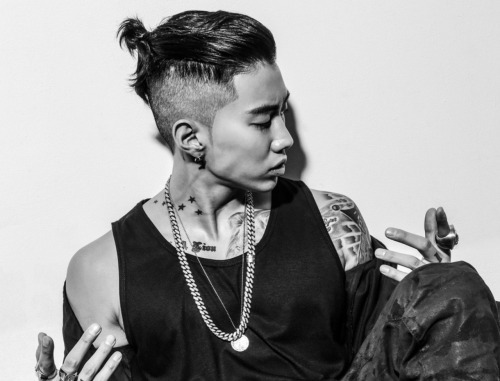
Eric Nam - Atlanta, Georgia
Eric Nam was born in Atlanta, where his family stills resides. In fact, he just recently performed at his hometown as part of his U.S. tour. He later attended university at Boston College and was about to begin a career as a business analyst in NYC. However, he decided to pursue his real dream of becoming a singer after MBC saw one of his cover videos on YouTube and invited him to Korea to compete in a music show. Just a few months later, he was one of the finalists and ended up being signed by a music company to begin his official solo career.
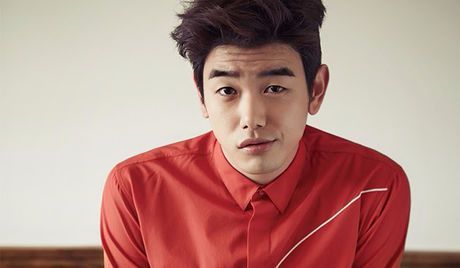
Ailee - Denver, Colorado
Born in Denver, Ailee was actually raised in New Jersey. She originally made her debut as a singer in the USA, where she was signed to a small label in NYC. After uploading videos to YouTube, she made the decision to go to Korea for an audition. When she sang, the label fell in love with her voice and decided to sign her on the spot. She then made her Korean debut in 2012 and went on to become one of the most famous voices in Korea, earning respect from both fans and music critics for her powerful and emotional vocals.

Jessica and Krystal Jung - San Francisco, California
Jessica and Krystal Jung were on vacation and enjoying some time in a shopping mall when an agent from SM Entertainment spotted them. Although the label wanted to begin training Krystal at the time, the girls' parents felt she was too young and decided that only Jessica would be allowed to begin her music career. Jessica went on to debut as a member of SNSD, and Krystal was also allowed to finally pursue her dreams several years later at the age of 12. She then debuted as a member of f(x), joining her sister at SM.

SEVENTEEN's Vernon - NYC, New York
Born in NYC to a Korean father and an American mother, Vernon moved to Korea as a child. He stated that he was a very ordinary kid with normal hobbies and friends. However, during his second year of middle school, he was scouted by an agent as he went home from school on the subway. Vernon went on to debut as part of SEVENTEEN in 2015. The group quickly rose to the top ranks of Kpop, due in part to their unique concept of being "self-producing" idols.

NCT's Johnny - Chicago, Illinois
Johnny Seo auditioned for SM Entertainment at the age of 12 years old during the 2007 SM Global Audition in Chicago. Through the audition, he was ultimately accepted and became his training period. Through his time with SM Rookies (a training group which eventually spawned Red Velvet and NCT), he gained a fanbase even before his official debut. Ten years after passing his initial audition, he finally made his debut as a member of NCT 127.

Amber Liu - Los Angeles, California
At only 25 years of age, Amber Liu has already been active for nine years in the Kpop industry. Back in 2008, she was only one of two people who passed a local audition to get into SM Entertainment. After training for one year, the Taiwanese-American made her debut as a member of f(x) in 2009. In 2015, she also went on to debut as a soloist and quickly became one of the most-loved figures in the Kpop industry. Since then, she has also made her acting debut and also runs a successful YouTube channel where she connects with her fans in English.
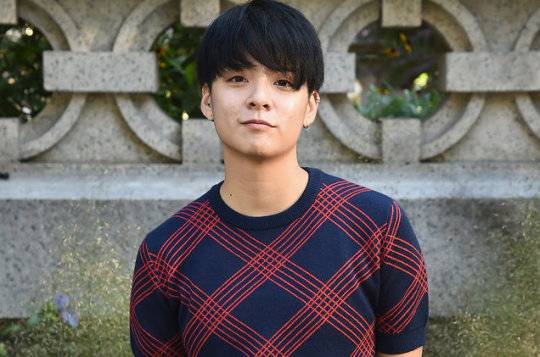
KARD's BM - Los Angeles, California
BM, real name Matthew Kim, trained for four years in Korea before making his official debut as a member of KARD. Before his debut, he worked as a dancer and appeared in projects like the music video for "Choco Chip Cookies" by Goo Hara. In December of 2016, KARD dropped their first song "Oh NaNa" as a pre-release project. They then went on to make their official debut in July 2017 with "Hola Hola." BM quickly became well-liked among Kpop fans for his down-to-earth sense of humor and amazing dance skills.
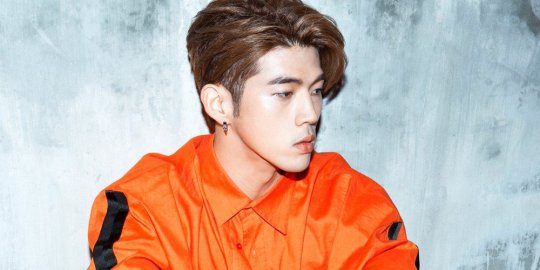
GOT7's Mark Tuan - Los Angeles, California
Mark Tuan was born in California before moving to Paraguay and Brazil. He and his family eventually moved back to the USA where he grew up and attended school. In fact, during lunch at school, Mark got on a table and started dancing and acting silly with his friends. A JYP Entertainment staff member happened to be there at that moment and decided to recruit him immediately. Mark said that he only decided to audition because his school encouraged him to do so, and it wasn't until he first stood onstage that he fully realized that he had truly found the place he belonged.
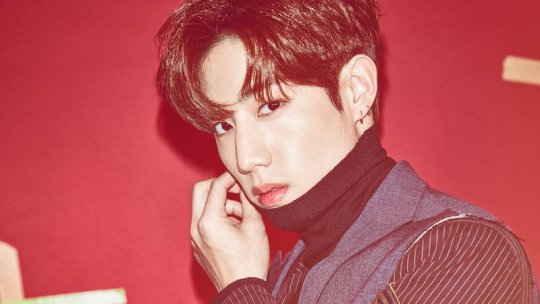
SEVENTEEN's Joshua - Los Angeles, California
Joshua has always been a very musical person and first started performing as a member of the praise team at his church in California. He later attended a festival in the USA and was playing the guitar when Pledis Entertainment took notice of the young musician. After watching him and considering things for approximately a month, they decided to reach out to see if he would want to become a Kpop idol. Joshua has stated before that music is his life, so as such, he agreed to sign with them and made the move to Korea.
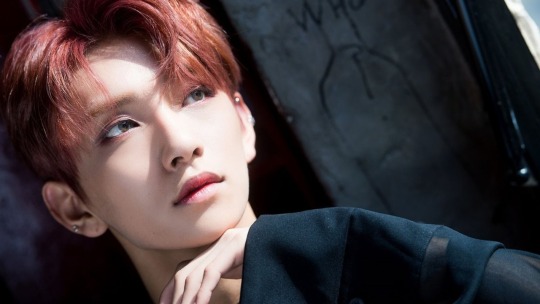
BTOB's Peniel Shin - Chicago, Illinois
Peniel may be a member of one of Cube Entertainment's most popular groups, but in fact, he first auditioned to become part of JYP Entertainment. After auditioning in his hometown of Chicago, he was signed by JYP and went to Korea to train. He stayed with the company for two years and even made an appearance in San E's music video "Tasty San." He eventually left JYP and was signed to Cube, where he was added to BTOB as the seventh and final member of the group before making their debut in 2012.

Alexandra Reid - Lawrence, Kansas
Alex, as she was known during her time as a member of BP RaNia, actually made her debut in the USA before she decided to venture into the Kpop world. Born in Kansas and raised in Texas, Alex was cast in a program for the Discovery Kids' network. Her MySpace profile was later noticed by a casting agent, who convinced her to move to NYC. She was then signed to Def Jam Recordings and Sony Music, where she was managed by the famous Scooter Braun. She made her official debut in 2011 and released music steadily for several years before officially joining BP RaNia. Although she left the group in 2017, she then went on to make a comeback as a soloist in March of 2018 with "East West."

Kevin Woo - Danville, California
Kevin's mother, a former fashion model from Korea, enjoyed watching Korean music shows at home. During this time, Kevin begin to notice groups like TVXQ and Super Junior and grew interested in Kpop. He later begged his mother to take him to a JYP and Rain concert being held in California and became even more interested in Kpop as a result. During a visit to Korea, he asked his parents to allow him to audition for some companies and was subsequently cast at the age of 15. He made his debut only a few months later as a member of XING. He later re-debuted under a new label as a member of U-KISS and achieved great success in both Korea and Japan. Kevin now works as a soloist, entertainer, and musical actor.

NU'EST's Aron- Los Angeles, California
While attending a festival in Los Angeles, Aron was approached by a casting agent. After deciding to audition, Aron went on to place first at the 2010 Pledis USA Auditions. As a result, he was signed to the company and began his time of training at the age of 17. He had been accepted into the journalism program at NYU but decided to give it up to pursue music. He then began to make appearances— including being a backup dancer and appearing in music videos— as one of the "Pledis Boys." He then made his official debut as a member of NU'EST in 2012.

2PM's Nichkhun- Rancho Cucamonga, California
Nichkhun's parents are from Thailand and his grandmother is Chinese, but this talented guy was born in California. However, he later moved to both Thailand and New Zealand before ultimately returning to California for school. In fact, it was at the local Los Angeles Korean Music Festival (the same festival that NU'EST's Aron was attending and subsequently cast at) that a casting agent from JYP Entertainment approached him and asked him to audition. He was working as a highschool coach at the time, but decided to take a chance on music and move to Korea to begin training.

Samuel Kim- Los Angeles, California
Born to a Mexican father and Korean mother, Samuel's name is actually Samuel Arredondo. However, when he decided to become a singer in Korea, he took on his mother's maiden name for his stage name. He was first signed to Pledis Entertainment and began training at age eleven to become a member of the group SEVENTEEN. However, he left the company and signed to Brave Entertainment after Pledis reportedly decided he was still too young to debut. He then became a member of the short-lived duo 1PUNCH. However, it wasn't until his appearance on season two of "Produce 101" that he finally began to receive the attention he deserved. After gaining a huge fan base due to the show, he made his debut as a soloist. A few months later, he made his official Japanese debut as well

There are numerous other Americans who have gone on to become great Kpop stars in Korea! Some of them were born in the USA (like U-KISS's Eli Kim) while others were simply raised there (like 24K's Cory). No matter where they were born or where they may travel, we know they will always be representing America in the best way possible— as talented, funny, kind, amazing artists and human beings!
Which American Kpop idol is your favorite? Who else should we have included on the list? Let us know in the comment section below!
lee1086 is the director of What The Kpop and a hardcore Kpop fan. When she hears "American Idol," she doesn't think of the TV show. Instead, she thinks of all the amazing Kpop idols who hail from the USA! She admits to a certain fondness for these fellow Americans, especially Amber Liu, Eric Nam, Kevin Woo, and Mark Tuan. Although she should be eating hot dogs and watching fireworks this 4th of July, she is writing Kpop articles instead.
Media: As Credited
Read the full article
#2PM#Ailee#AlexReid#AmberLiu#american#Aron#BM#BTOB#EricNam#f(x)#got7#idols#JayPark#JessicaJung#johnny#Joshua#KARD#KevinWoo#kpop#KrystalJung#MarkTuan#NCT#Nichkhun#Nu'est#PenielShin#SamuelKim#SEVENTEEN#U-KISS#Vernon
0 notes
Text
81. The 1990 off-season --- Expansion: Team 29: Southwest Area
“Maloof’s folly”
…At least that was the headline to an editorial in March in Albuquerque for the Maloof brothers’ announced Albuquerque team. They questioned the value the team would bring to the league and to the Turner Broadcast Network. They did not know that Turner (Atlanta’s owner) had had regular discussions with Gavin Maloof when Maloof was thinking about selling the Birmingham Stallions.
Turner rubberstamped the Albuquerque franchise so he could use the team’s games to sell Spanish broadcasts to Univision for simulcasts. Turner rightly assumed that all exposure was good, revenue generating exposure that narrowed the gap between the USFL and NFL.
The State and City Governments had agreed to contribute $40M to upgrade UNM’s University Stadium. In the Spring of 1990 an upper deck would be built raising capacity to 40,000 and adding a significant number of luxury boxes and bathrooms. During the Lobos’ 1990 season the crews would return to work as soon as the weeks’ games concluded. They would add new chairbacked seats along the sidelines.
The team acknowleged that building a single upper deck was one of the cheaper ways to get capacity up to where they needed it, but they would be very concerned with the thought than a strongly unbalanced capacity stadium could hurt attendance. A promise was made to the team that as soon as the team hit 30,000 in attendance, the city would build another matching deck raising capacity to 46,000.
The Maloofs would see beyond the state’s relatively small and poor population and instead choose to view the team as a team that all Mexican Americans would support. They knew that with Turner alone providing a $15M per team TV payout, the attendance weakness of the smaller stadium site was no longer a deal breaker.
Merchandise sales in a larger region than just New Mexico would make up those shortfalls anyway. Along marketing lines they liked what the University of New Mexico had done in choosing “Lobos” — spanish for wolves — as their mascot.
“We liked ‘The New Mexico Quetzals’ for a long time.” Gavin Maloof would say years later. “Putting New Mexico in front of anything is a mouthful, but we thought ‘New Mexico’ would be easier for fans out of state than ‘Albuquerque’, and it puts ‘Mexico’ into the name. ‘The New Mexico Quetzals’ sounded about right…. But ultimately it was a bird and we wanted something more attention grabbing.”
“When someone suggested “Chupacabras” we knew that was it.
“The New Mexico Chupacras” is a mouthful, but it is totally Mexican, with just the right amount of Macabre to be cool.”

The team would hire former Dallas Cowboys QB and Denver Gold head coach Craig Morton.

Morton had been fired after his Gold team had collapsed under injures including the loss of their QB Craig Penrose, but it wasn’t lost on Maloof that the player’s coach Morton had a .500 record in the USFL over a season and a half and there was every reason to believe he would have had a better record if Penrose hadn’t been injured…..and if the Gold ownership hadn’t traded away Denver’s two best linebackers in the pre-season in a cost saving move.
“I knew that .500 was our magic number. If you can get around that in football, you give fans hope and they come to games. Everyone wants to win the title every year and I am no different, but with 29 teams that wasn’t going to be a realistic annual dream. We just didn’t want to be bad. A team within sight of a 500 record each year was a realistic goal and we thought Morton was the guy to get us there.”
Morton would encourage the team to try to acquire veterans from Denver, Arizona, and San Antonio and to specifically try to acquire the rights to all the former Air Force stars from the 80′s teams. Morton would make the case that New Mexico USFL fans were currently fans of Arizona, San Antonio, or Denver, so any signings off those roster would have positive PR gains as well as filling playing roles on the team.
He also encouraged the team to look into former Dallas Cowboys.
There was a logic to his thinking. He knew first hand how the Gold had drawn well by signing former Bronchos players. There was no NFL team in New Mexico for him to cull players from. The smartest course of action in terms of building fans was to pull as many college players as possible from the team’s territorial assignments, the University of New Mexico, New Mexico State, UTEP, Texas Tech, and Air Force, but talent from those schools would not fill a roster.
Air Force’s collection of 1980′s All-Americans would be some of the best talents produced by those universities. With New Mexico’s large military personnel in state, securing those players from the academy who had signed with Denver would be a priority along with acquiring former UNM star WR Terance Mathis.
Morton needed quality veterans. He knew many of the Gold players and knew which ones he could work with.
San Antonio was coached by his former NFL head coach, Tom Landry. He knew how Landry operated, had friends in the Gunslinger organization, and respected the way Landry developed talent.
He also had some insights into the Wranglers organization.
These ties would serve him well as he quickly ramped up the team’s talent level.
The Chupacabras would be team 29.
Click here to continue to the next post
Click here for previous post
0 notes